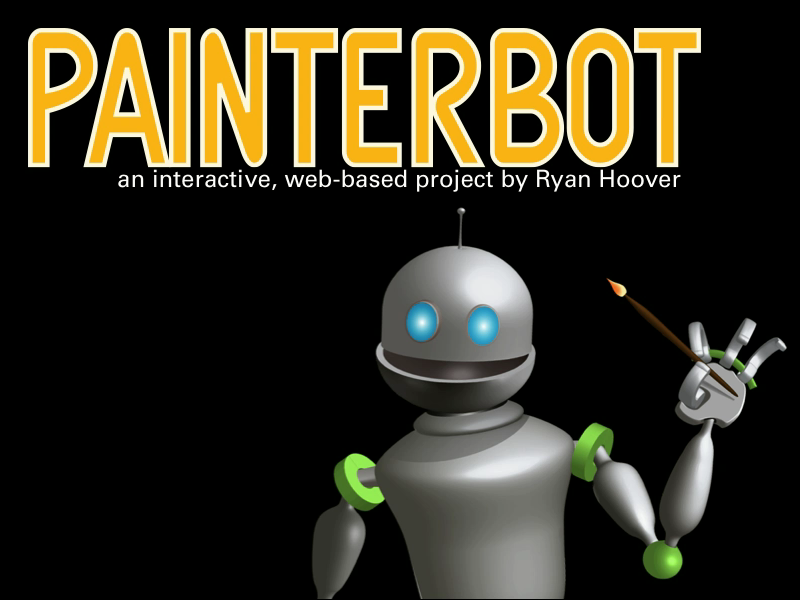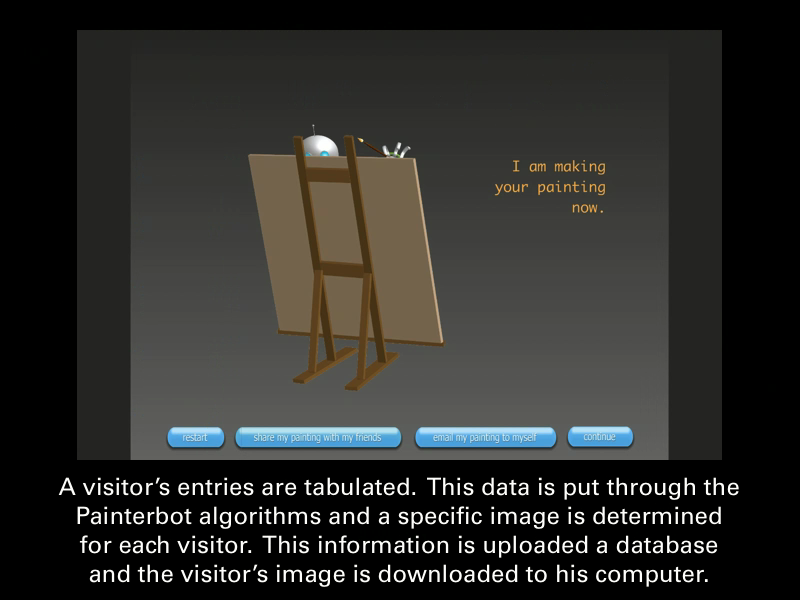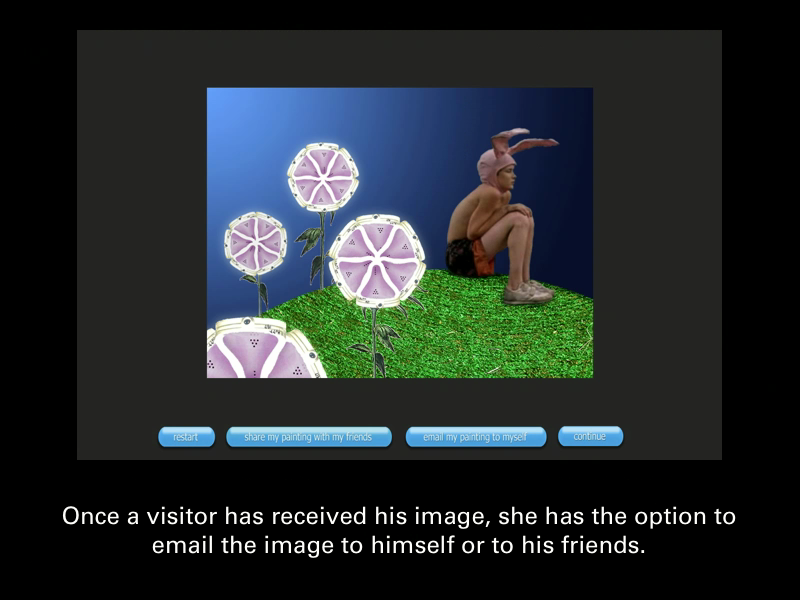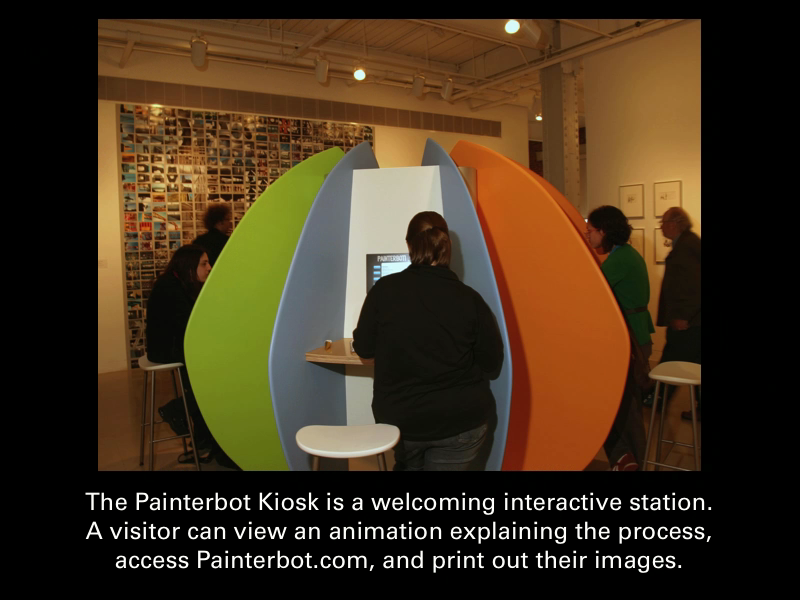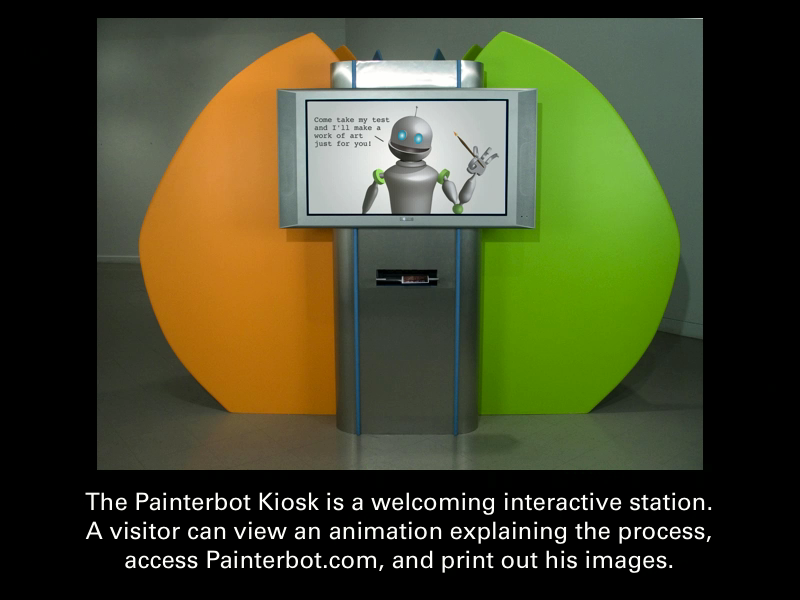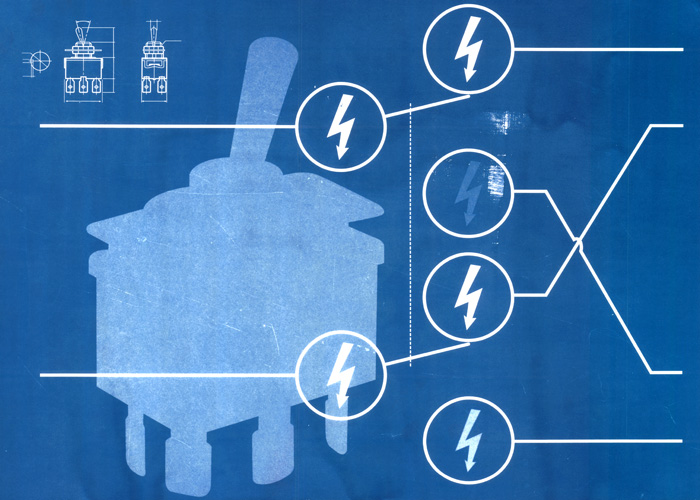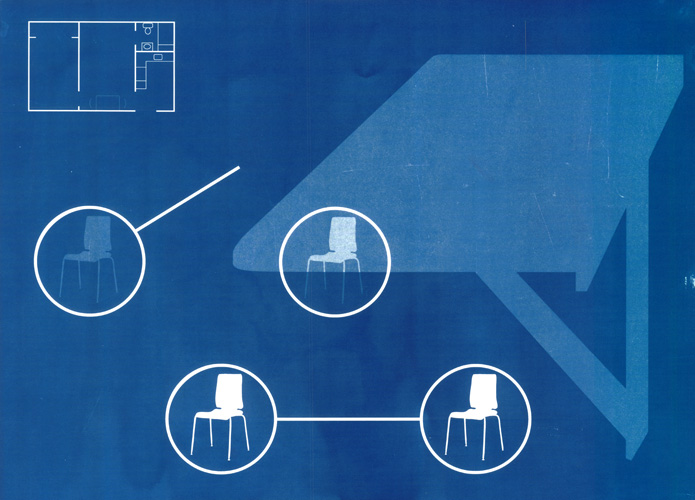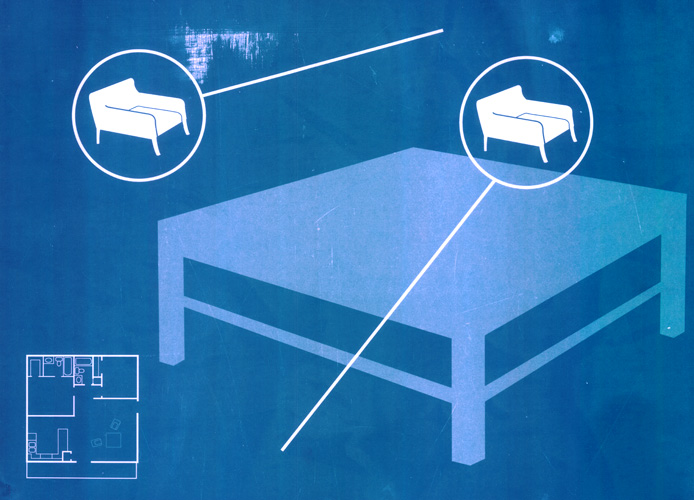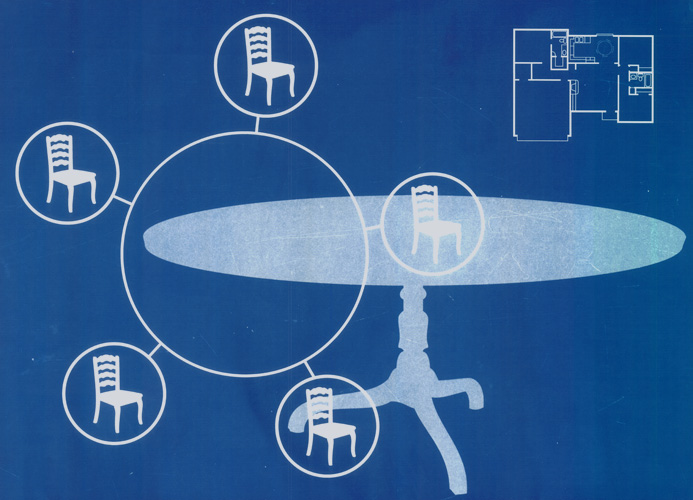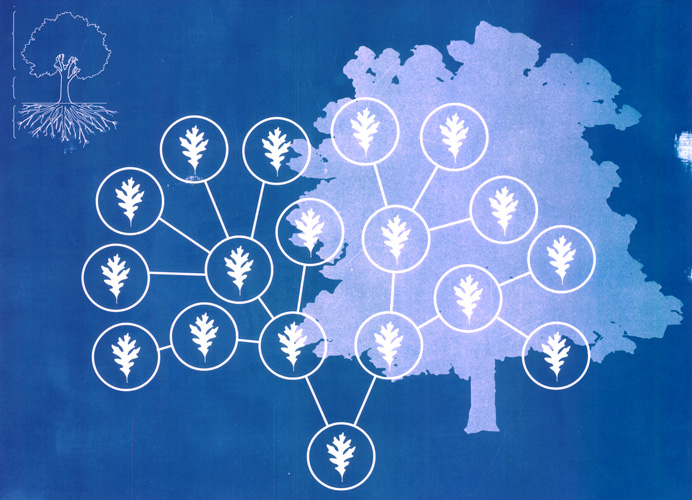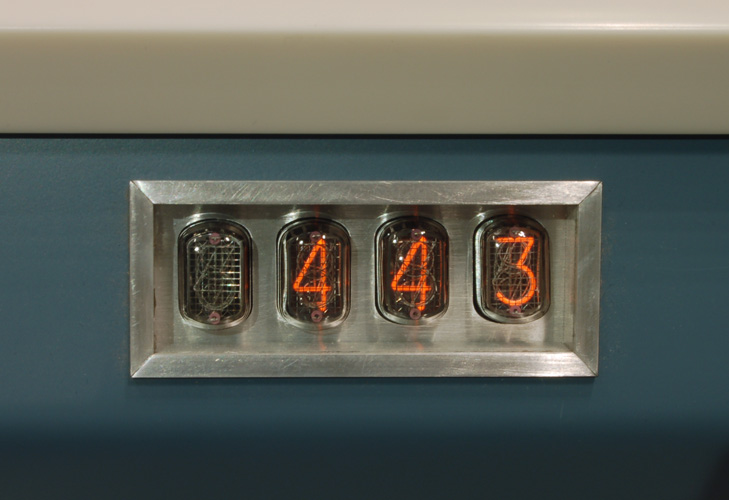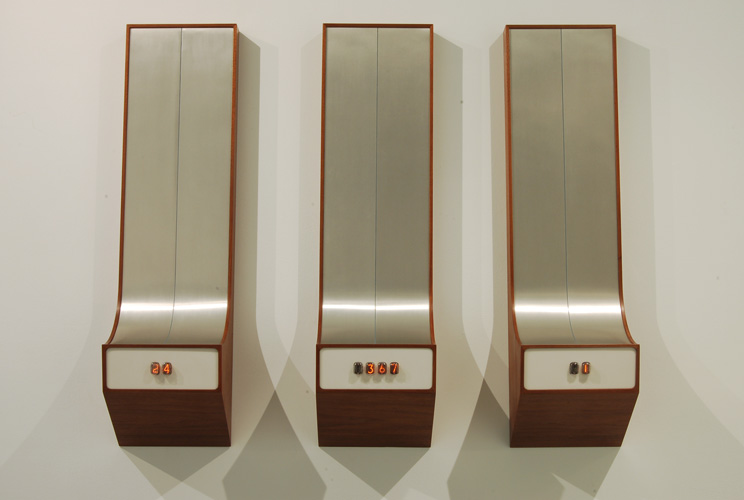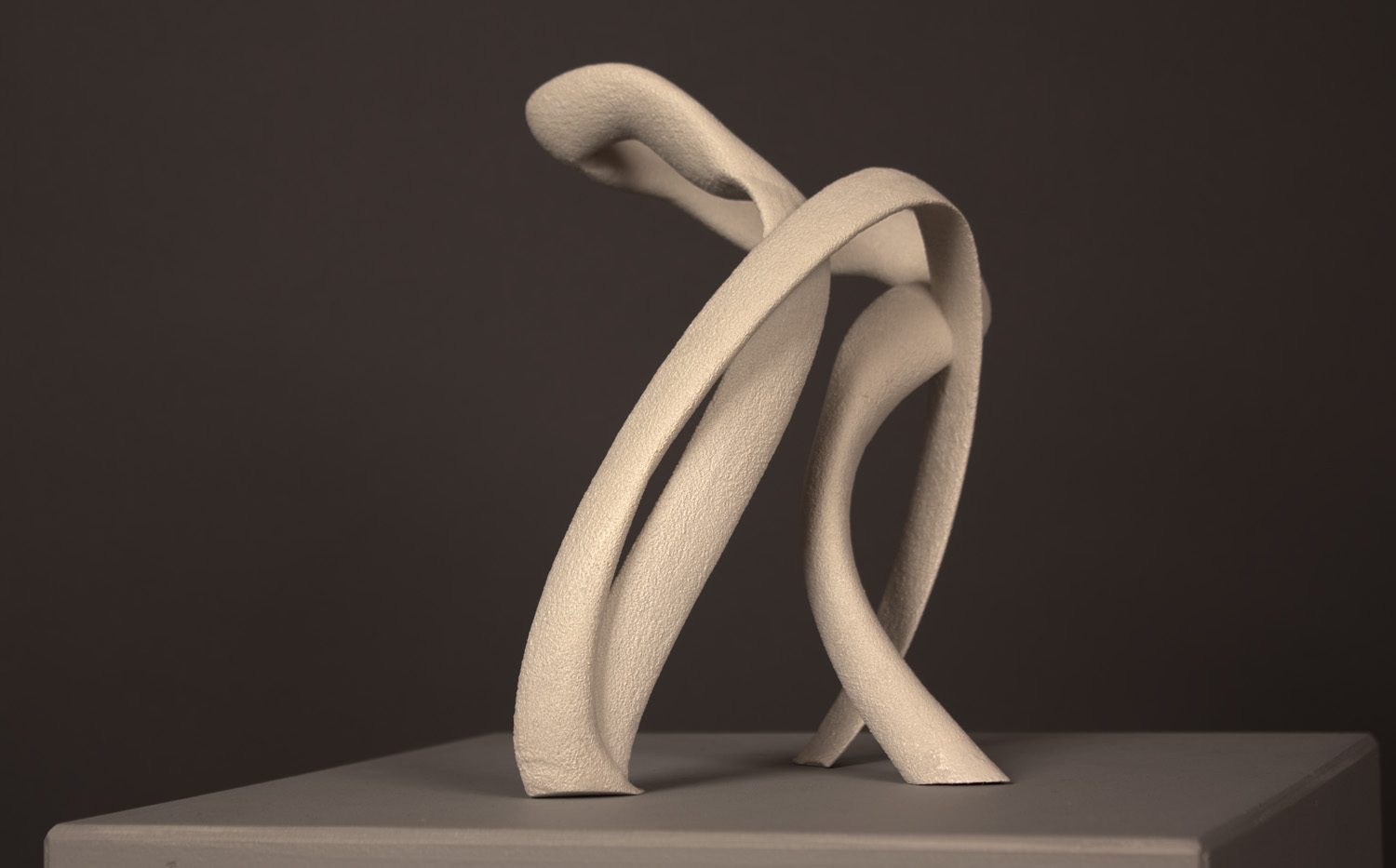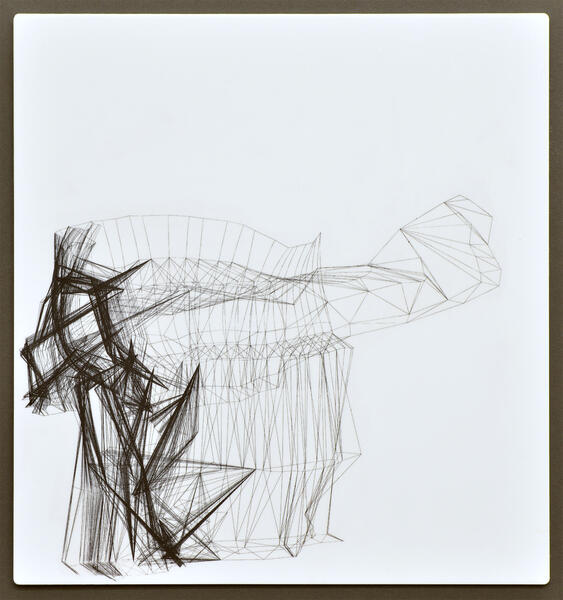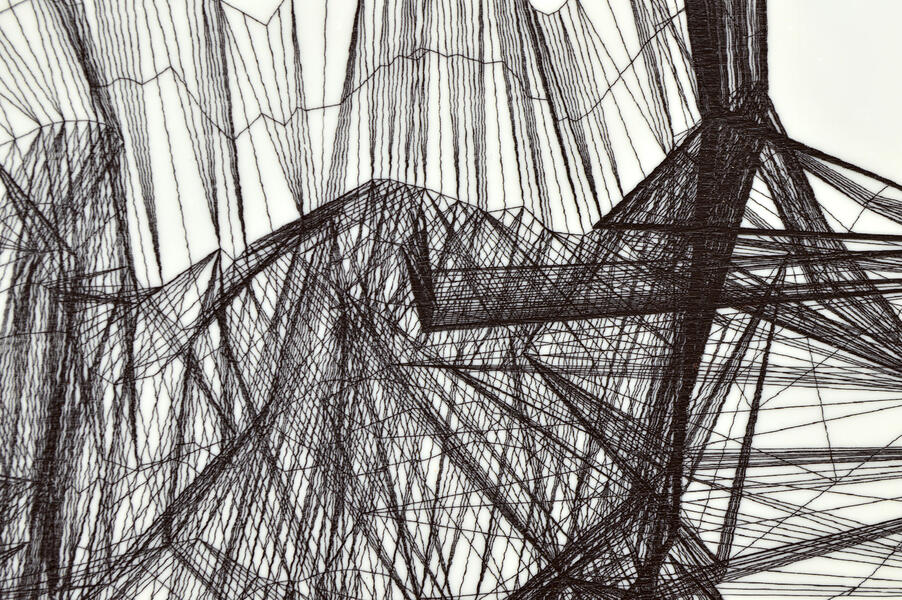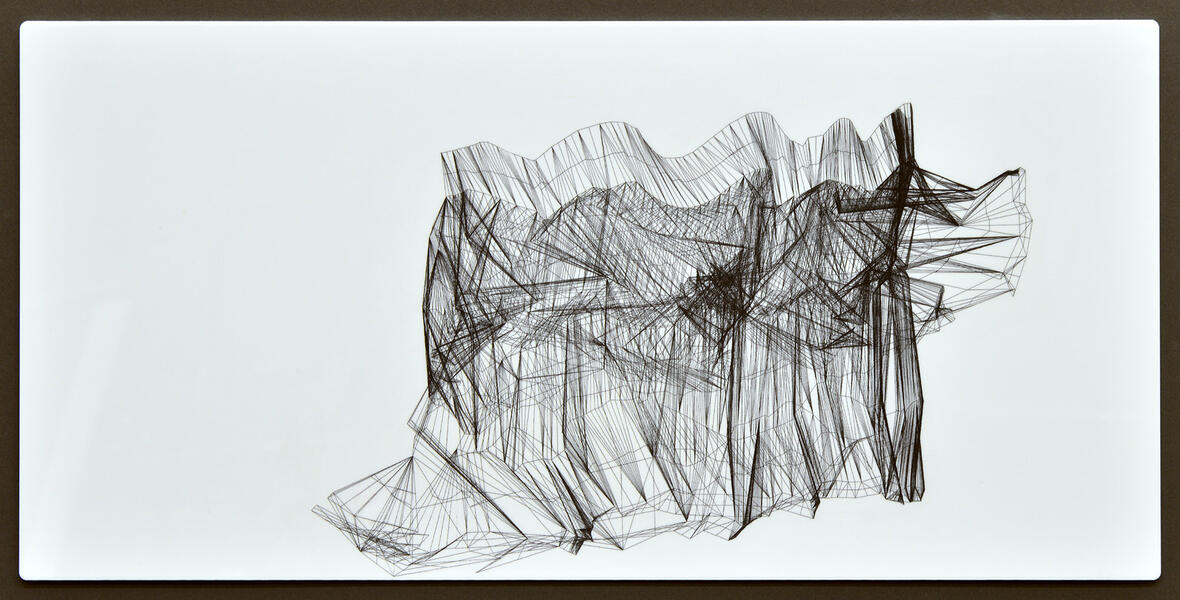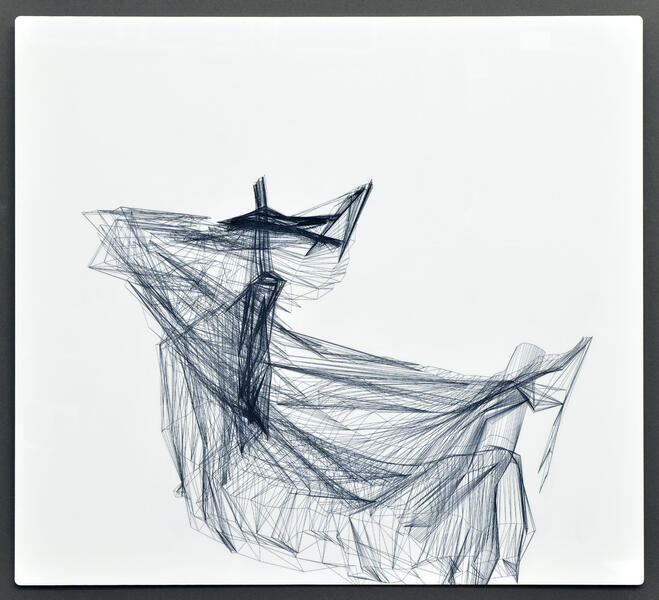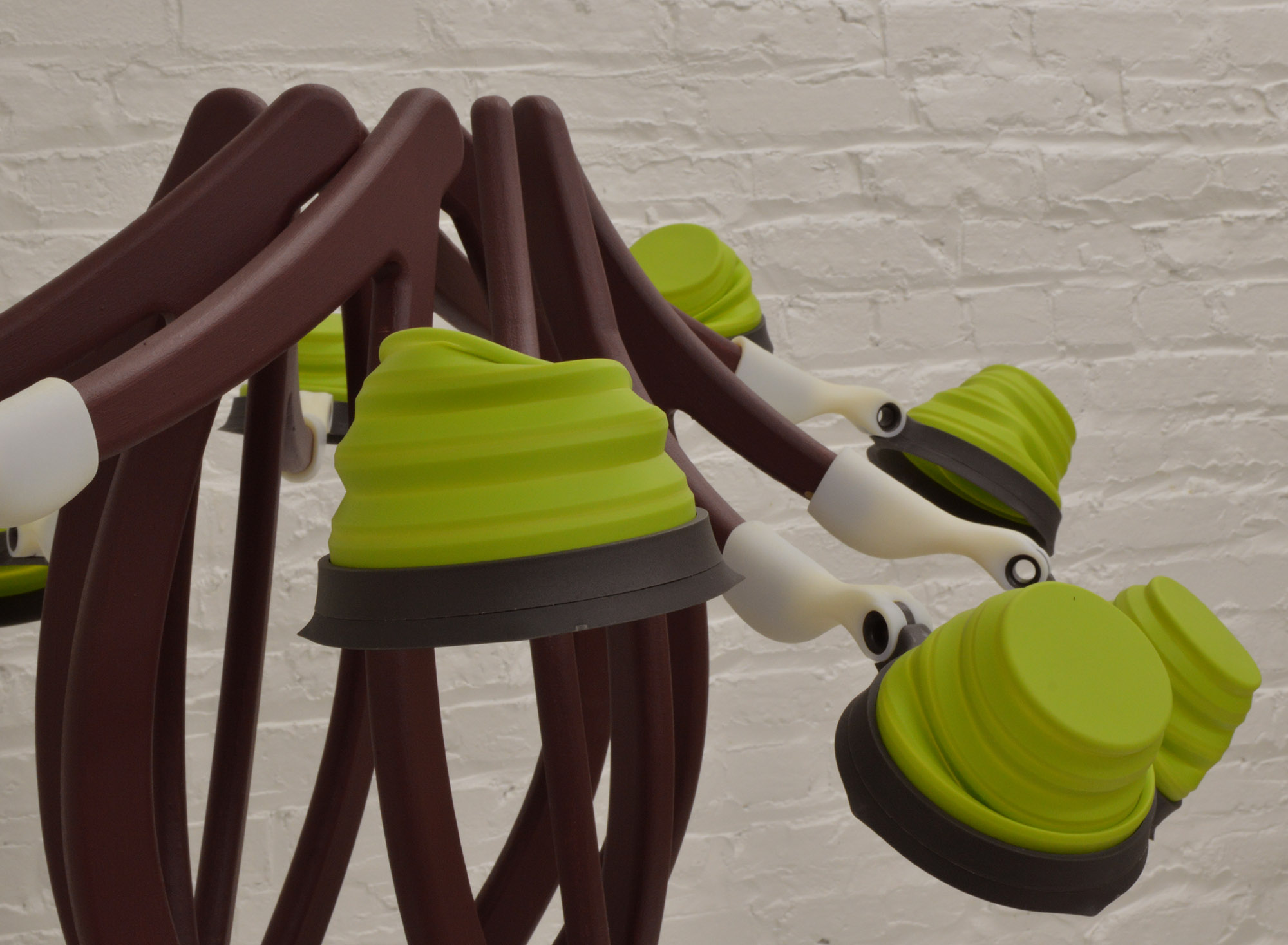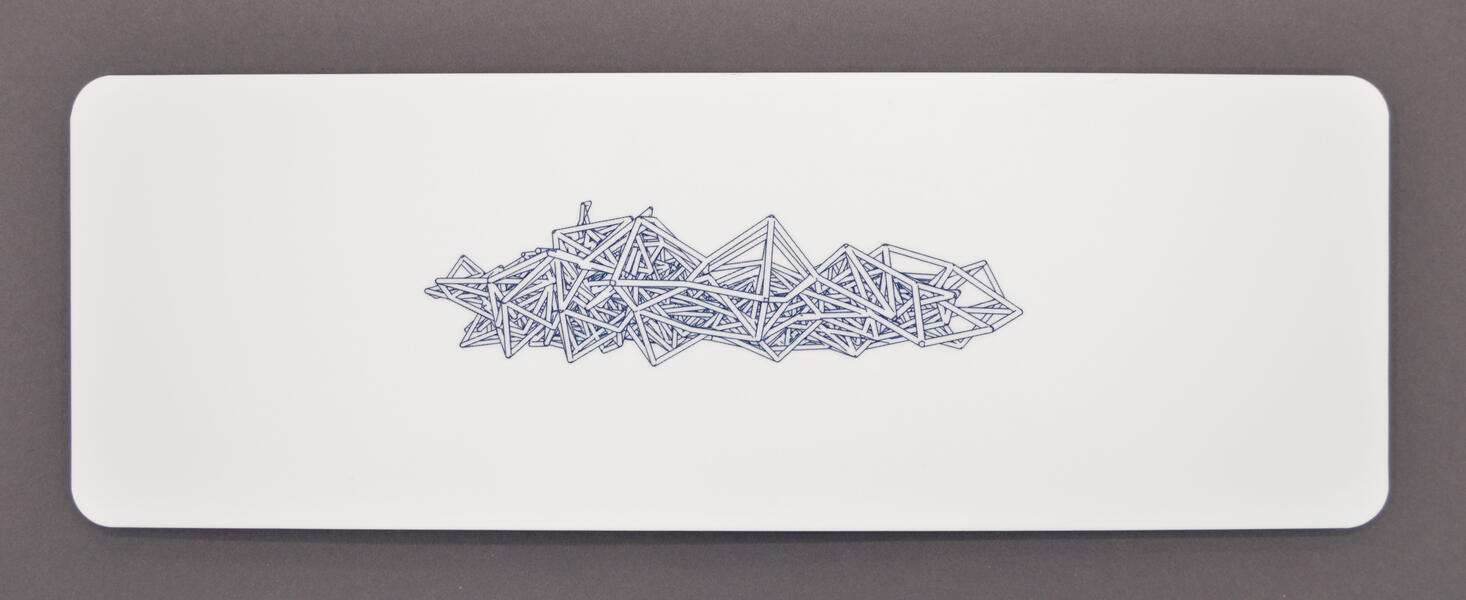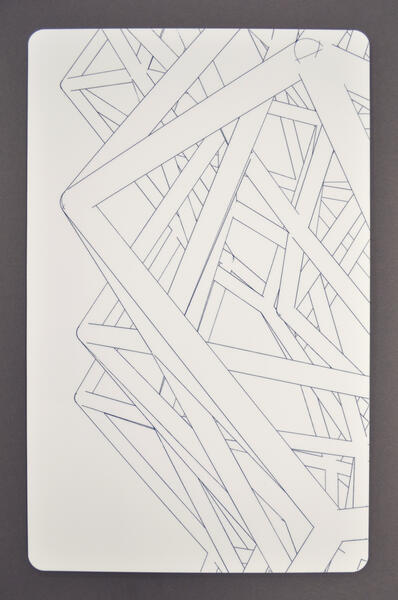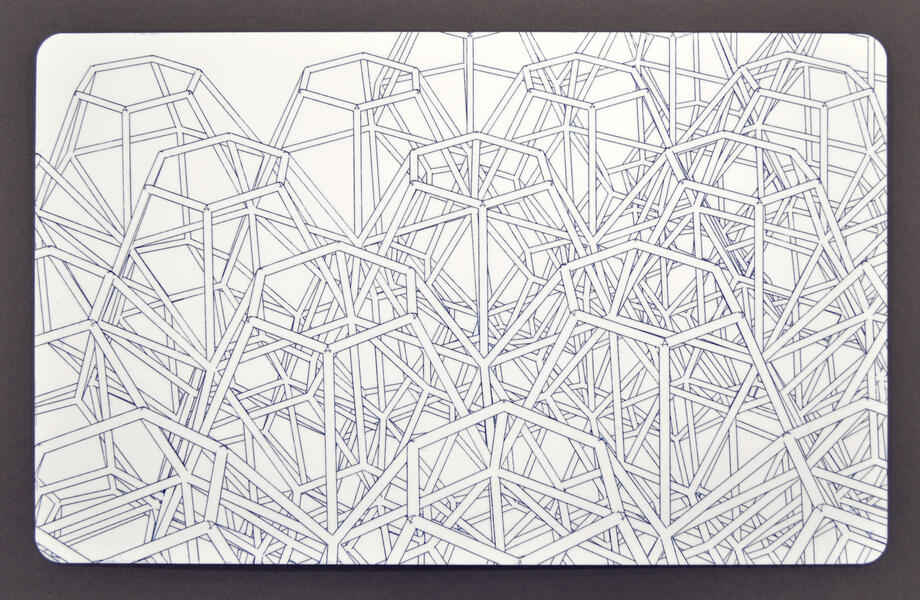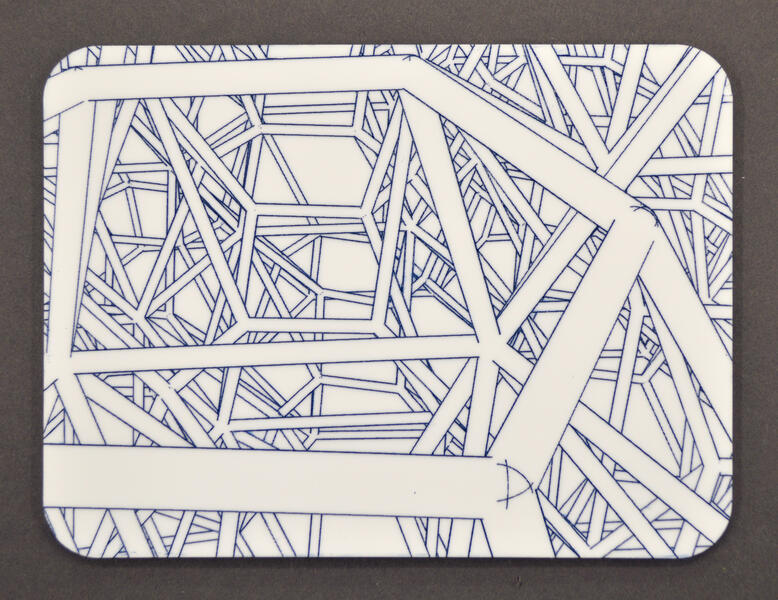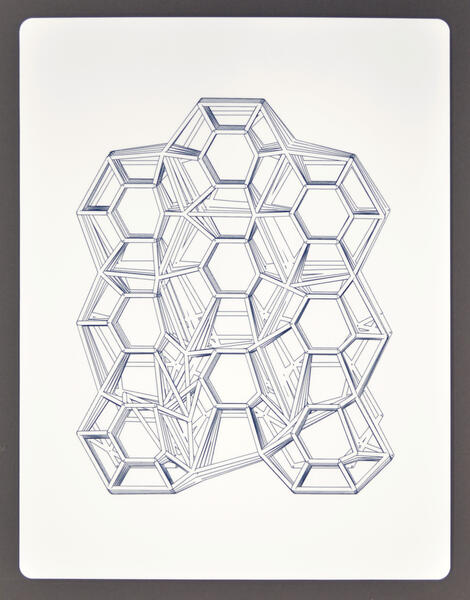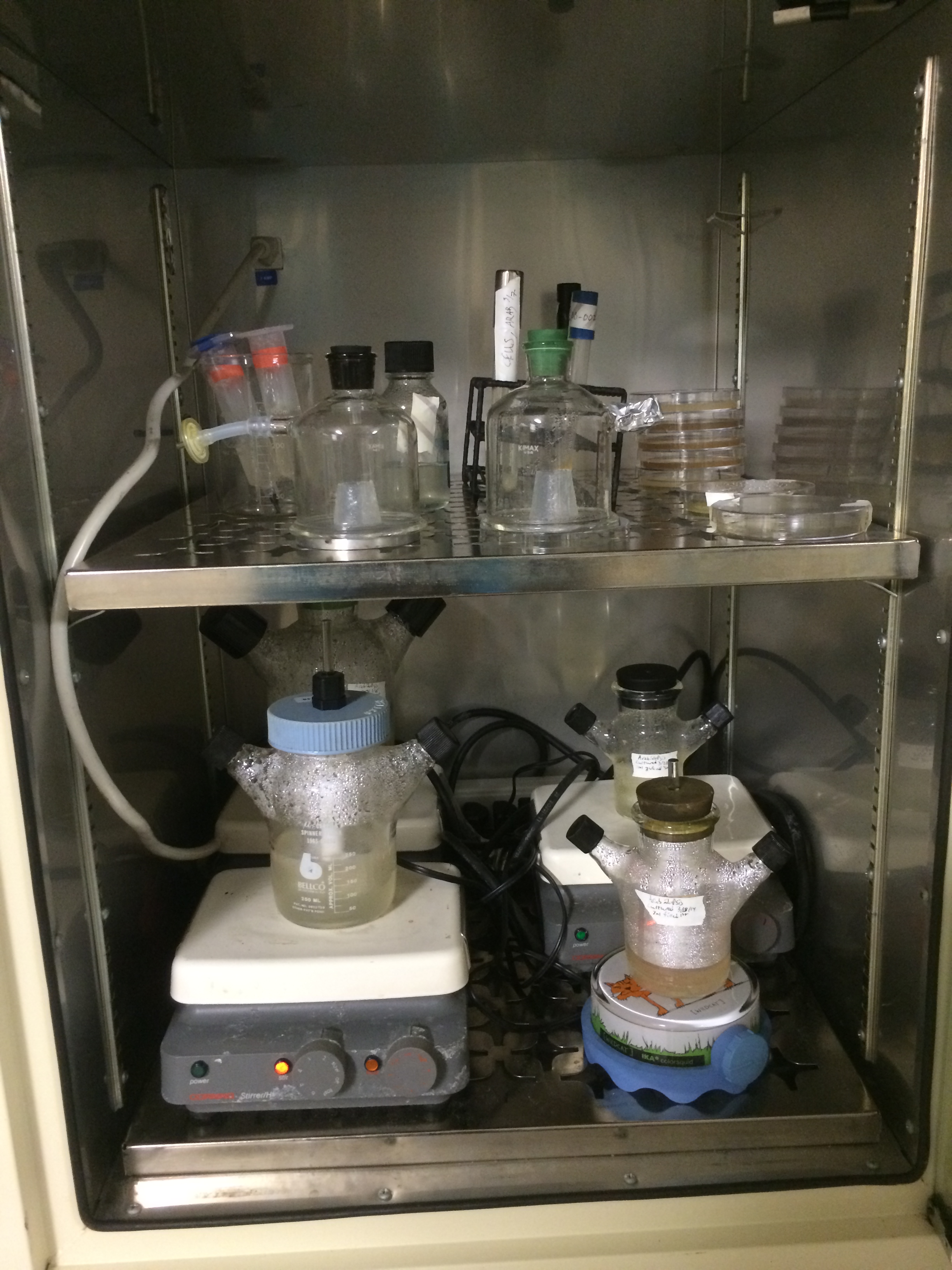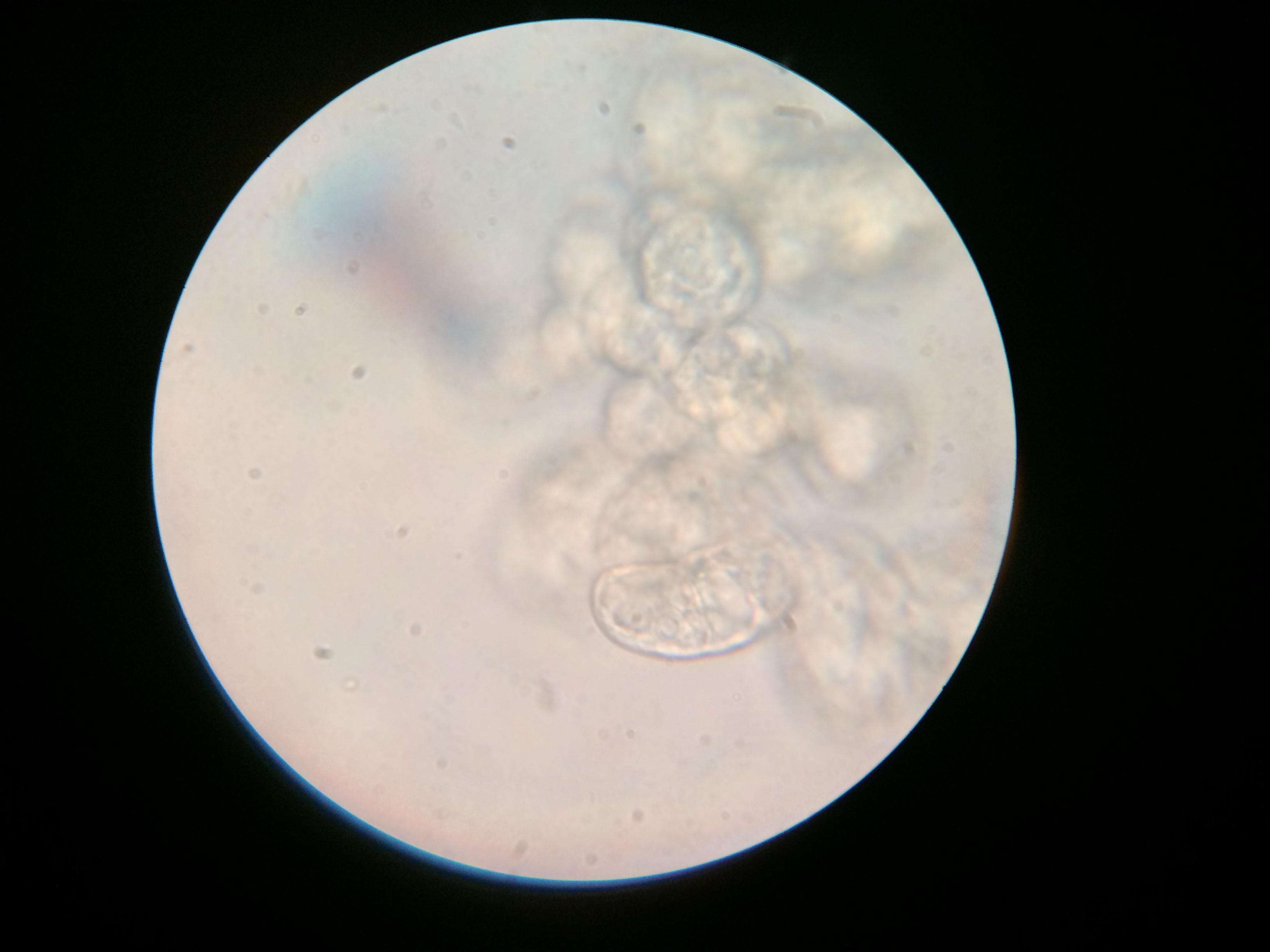About Ryan

Ryan Hoover is an artist who employs a range of digital, biological, and traditional artistic media to explore technology and its history, critically reflecting upon the manner in which it structures our society and shapes us as individuals. He holds a dual degree from the University of North Carolina at Asheville in Philosophy and Fine Art (Sculpture) and an MFA from the Mount Royal School of Interdisciplinary Art at the Maryland Institute College of Art. Hoover is a full time faculty… more
Jump to a project:
Painterbot
Painterbot.com is a site where visitors can take a personality test and "Painterbot" generates a work of art that matches their personality. This can be done from the Painterbot Kiosk or any computer connected to the internet. Visitors are categorized and their data is stored in Painterbot's database.
This piece looks at the merging of psychology and marketing. It reflects on on how psychographic marketing profiles are constructed and how they are mapped back onto the individual.
Contemporary marketing strategies are focused on developing "narrow-cast" marketing tactics that draw upon detailed customer profiles. The means by which these profiles are constructed are often covert, and the ways that they are employed are often unknown to the individual who is targeted. These profiles can influence consumers' purchases, politicians' agendas, employers' hiring decisions, and psychologists' understanding of human beings.
Go to www.painterbot.com to take the test yourself.
This piece looks at the merging of psychology and marketing. It reflects on on how psychographic marketing profiles are constructed and how they are mapped back onto the individual.
Contemporary marketing strategies are focused on developing "narrow-cast" marketing tactics that draw upon detailed customer profiles. The means by which these profiles are constructed are often covert, and the ways that they are employed are often unknown to the individual who is targeted. These profiles can influence consumers' purchases, politicians' agendas, employers' hiring decisions, and psychologists' understanding of human beings.
Go to www.painterbot.com to take the test yourself.
History Paintings
This series of black and white drawings/paintings are created with a very sculptural approach. "And We Reap" is carved into plaster and the recessed areas are then filled with paint. "Moving History" emerged from a subtractive process; layers of white paint were scraped and sanded away to reveal textured black paint below.
This series of paintings reflects on Late-Modernist principles and the people and technologies that brought these ideas into our lives. These paintings are created by a combination of human, digital, and mechanical processes. The images are constructed by various subtractive and additive methods. In some cases, the image is created using computer software and custom scripts written by the artist in PHP, then etched into painted panels using a laser-cutter. The etched areas are filled with paint of another color and the surface is laborously smoothed with razor blades and sand paper. This process yields a detailed image with distinct readings at the micro and macro levels.
This series of paintings reflects on Late-Modernist principles and the people and technologies that brought these ideas into our lives. These paintings are created by a combination of human, digital, and mechanical processes. The images are constructed by various subtractive and additive methods. In some cases, the image is created using computer software and custom scripts written by the artist in PHP, then etched into painted panels using a laser-cutter. The etched areas are filled with paint of another color and the surface is laborously smoothed with razor blades and sand paper. This process yields a detailed image with distinct readings at the micro and macro levels.
-
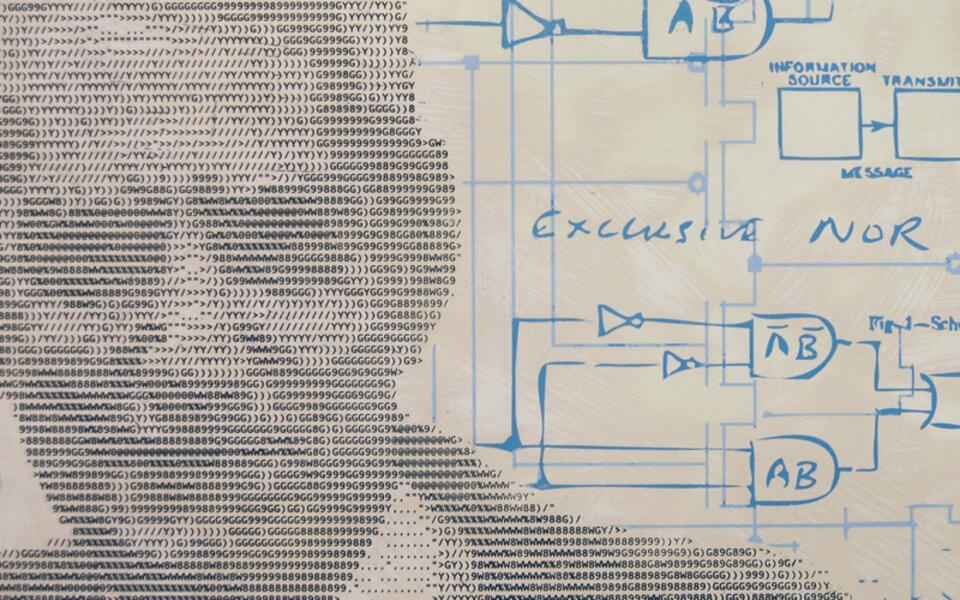 The Man Who Taught Electricity to Think, Claude Shannon (detail)28" x 19" | acrylic on MDF | 2007
The Man Who Taught Electricity to Think, Claude Shannon (detail)28" x 19" | acrylic on MDF | 2007 -
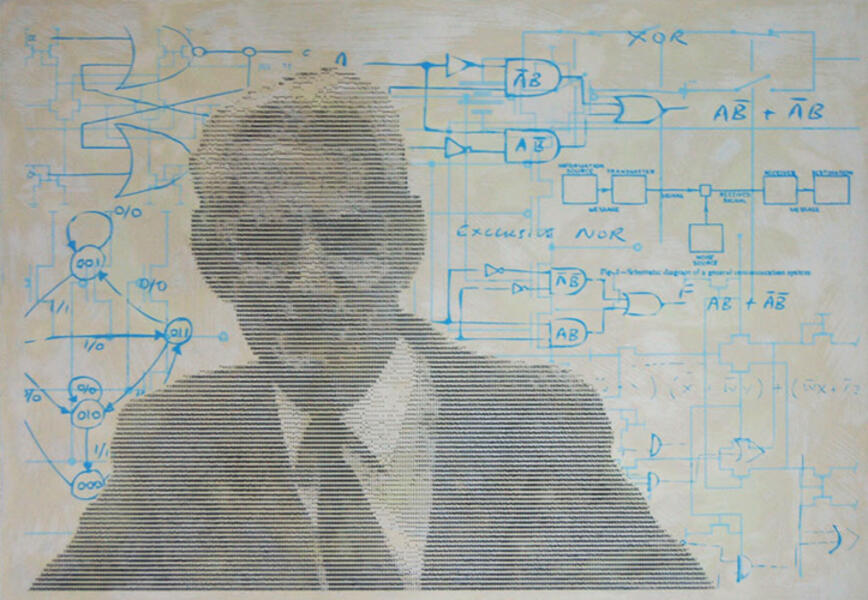 The Man Who Taught Electricity to Think, Claude Shannon28" x 19" | acrylic on MDF | 2007
The Man Who Taught Electricity to Think, Claude Shannon28" x 19" | acrylic on MDF | 2007 -
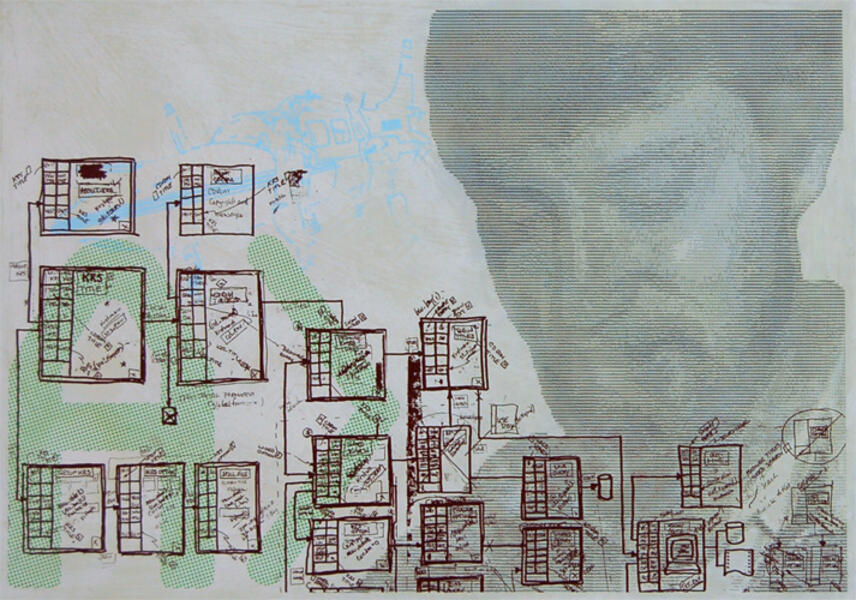 Control Programmer, Gary Kildall28" x 19" | acrylic on MDF | 2010
Control Programmer, Gary Kildall28" x 19" | acrylic on MDF | 2010 -
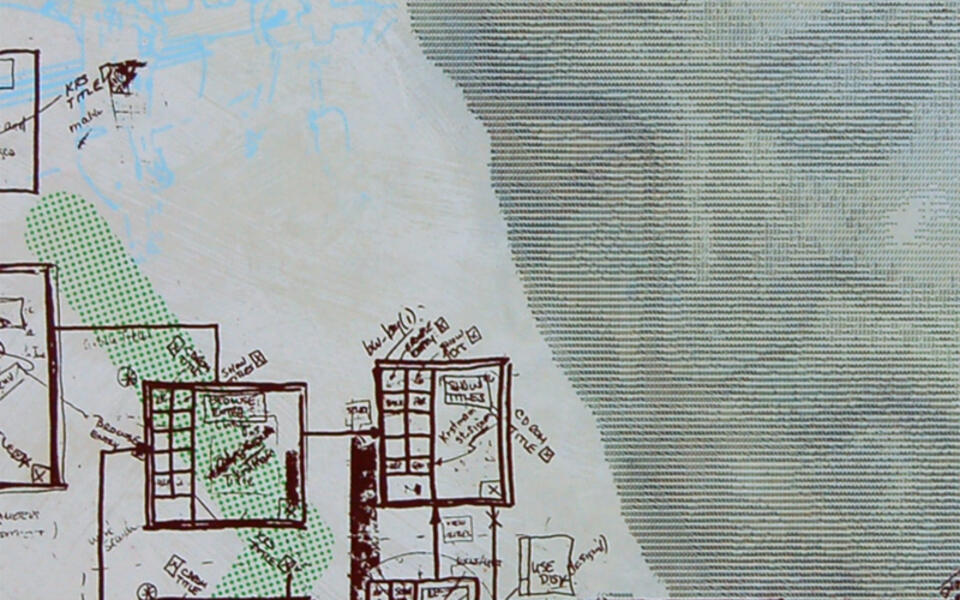 Control Programmer, Gary Kildall (detail)28" x 19" | acrylic on MDF | 2010
Control Programmer, Gary Kildall (detail)28" x 19" | acrylic on MDF | 2010 -
 morse_800x500.jpg46" x 9" x 2" | cast plastic, masonite, fiberglass rsein, aluminum epoxy, acrylic, graphite | 2011
morse_800x500.jpg46" x 9" x 2" | cast plastic, masonite, fiberglass rsein, aluminum epoxy, acrylic, graphite | 2011 -
 Moving History, Eadweard Muybridge48" x 59" | acrylic on MDF | 2004 "Moving History" emerged from a subtractive process; layers of white paint were scraped and sanded away to reveal textured black paint below. The photography of Eadweard Muybridge, the source imagery for "Moving History", is a combination of art and science and has had an impact on each of those fields.
Moving History, Eadweard Muybridge48" x 59" | acrylic on MDF | 2004 "Moving History" emerged from a subtractive process; layers of white paint were scraped and sanded away to reveal textured black paint below. The photography of Eadweard Muybridge, the source imagery for "Moving History", is a combination of art and science and has had an impact on each of those fields. -
 Moving History, Eadweard Muybridge48" x 59" | acrylic on MDF | 2004 "Moving History" emerged from a subtractive process; layers of white paint were scraped and sanded away to reveal textured black paint below. The photography of Eadweard Muybridge, the source imagery for "Moving History", is a combination of art and science and has had an impact on each of those fields.
Moving History, Eadweard Muybridge48" x 59" | acrylic on MDF | 2004 "Moving History" emerged from a subtractive process; layers of white paint were scraped and sanded away to reveal textured black paint below. The photography of Eadweard Muybridge, the source imagery for "Moving History", is a combination of art and science and has had an impact on each of those fields. -
 And We Reap, cannon mold30" x 96" x 4" | plaster, acrylic, wood | 2003 "And We Reap" is carved into plaster and the recessed areas are then filled with paint. A 17th century illustration of a cannon mold reveals the history of metal casting technology that is employed by artists today. Benefits created directly and indirectly by war introduce moral complications for every citizen, particularly those of the United States today.
And We Reap, cannon mold30" x 96" x 4" | plaster, acrylic, wood | 2003 "And We Reap" is carved into plaster and the recessed areas are then filled with paint. A 17th century illustration of a cannon mold reveals the history of metal casting technology that is employed by artists today. Benefits created directly and indirectly by war introduce moral complications for every citizen, particularly those of the United States today. -
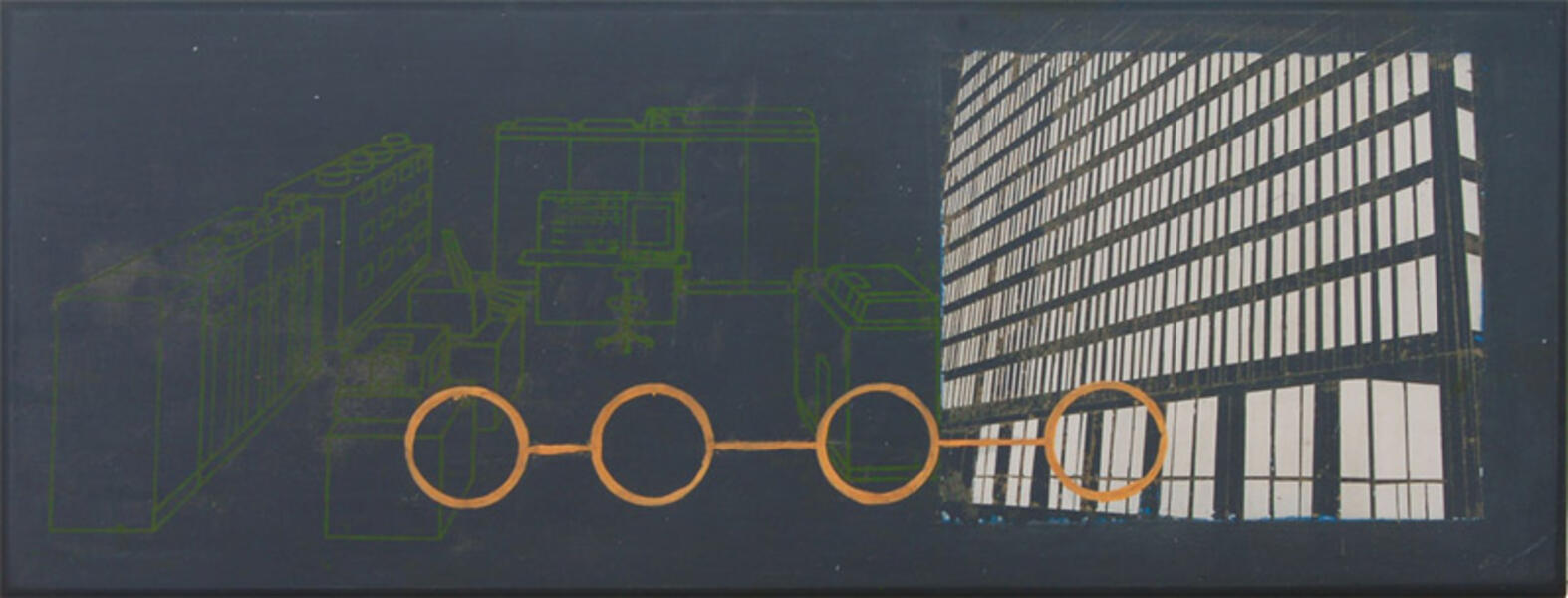 The Architectural Shift, IBM System 36028" x 19" | acrylic on MDF | 2008
The Architectural Shift, IBM System 36028" x 19" | acrylic on MDF | 2008
Atlas of Networks
The Atlas of Networks is a series of cyanotype blueprints that explore a diverse range of networks, examining their structures and effects in a broad philosophical sense and a focused technical sense. These diagrams reveal structural similarities in objects or situations that may not be expected. Such connections might stitch together a table, a toggle switch, and a moral argument. This project works across pre-existing taxonomical categories in an attempt to provide an alternative understanding of our evermore-complex world.
-
 Atlas of Networks: Toggle Switch (Dual Pole, Dual Throw)24" x 18" | cyanotype | 2010
Atlas of Networks: Toggle Switch (Dual Pole, Dual Throw)24" x 18" | cyanotype | 2010 -
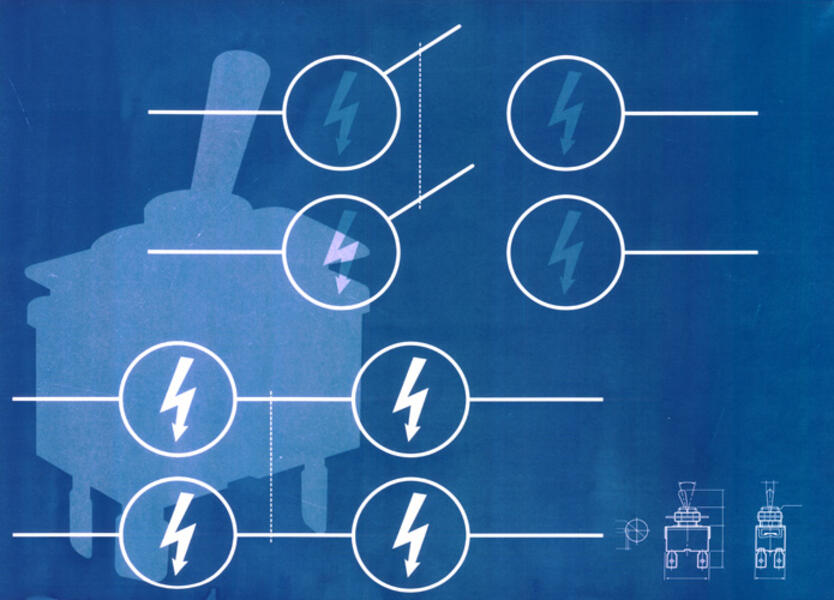 Atlas of Networks: Toggle Switch (Dual Pole, Single Throw)24" x 18" | cyanotype | 2010
Atlas of Networks: Toggle Switch (Dual Pole, Single Throw)24" x 18" | cyanotype | 2010 -
 Atlas of Networks: Hinging Table24" x 18" | cyanotype | 2010
Atlas of Networks: Hinging Table24" x 18" | cyanotype | 2010 -
 Atlas of Networks: Modernist Coffee Table24" x 18" | cyanotype | 2010
Atlas of Networks: Modernist Coffee Table24" x 18" | cyanotype | 2010 -
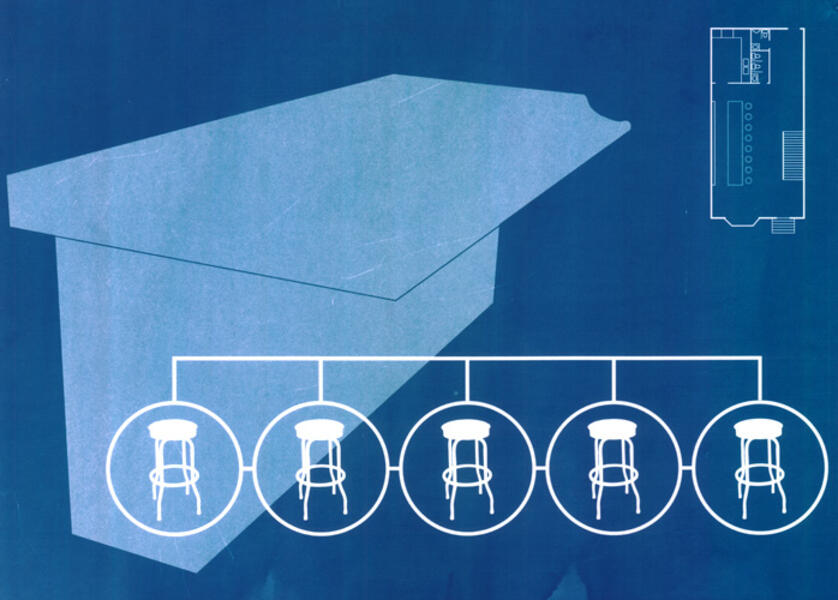 Atlas of Networks:Bar24" x 18" | cyanotype | 2010
Atlas of Networks:Bar24" x 18" | cyanotype | 2010 -
 Atlas of Networks: Circular Kitchen Table24" x 18" | cyanotype | 2010
Atlas of Networks: Circular Kitchen Table24" x 18" | cyanotype | 2010 -
 Atlas of Networks: Rectangular Dining Table24" x 18" | cyanotype | 2010
Atlas of Networks: Rectangular Dining Table24" x 18" | cyanotype | 2010 -
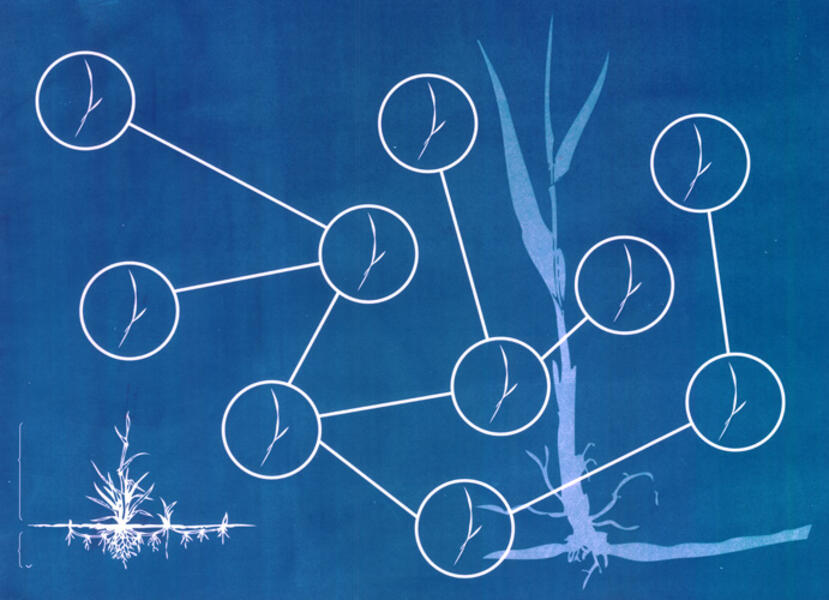 Atlas of Networks: Rhizomatic Grass24" x 18" | cyanotype | 2010
Atlas of Networks: Rhizomatic Grass24" x 18" | cyanotype | 2010 -
 Atlas of Networks: Oak Tree24" x 18" | cyanotype | 2010
Atlas of Networks: Oak Tree24" x 18" | cyanotype | 2010 -
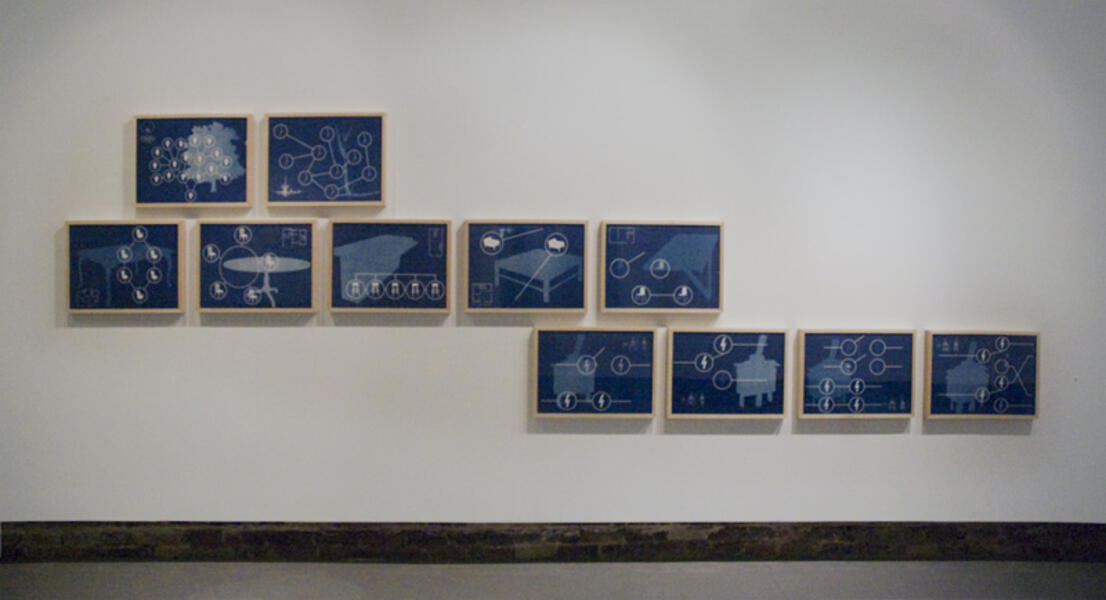 Atlas of Networks (installation view)192" x 58" | cyanotypes in maple frames | 2010
Atlas of Networks (installation view)192" x 58" | cyanotypes in maple frames | 2010
2200 Series
The 2200 Series continues my exploration of the networks that define and locate an individual socially, geographically, and otherwise, with a particular focus on the networks that function via digital means. These pieces look to 1960's mainframe computers as the antecedents of our contemporary situation, and explore overlaps with modernist furniture suites which themselves generate and exist within their own network. Each piece functions as a computer, retrieving web-based data about an individual and displaying this information in the piece. With this abstract information grounded in a tangible object, the viewer is able to reflect upon these networks in a new way.
-
 MX-220048" x 32" x 24" | walnut, steel, corian, aluminum, electronics | 2011 displays number of emails recieved in past 60 days from two seperate accounts
MX-220048" x 32" x 24" | walnut, steel, corian, aluminum, electronics | 2011 displays number of emails recieved in past 60 days from two seperate accounts -
 MX-220048" x 32" x 24" | walnut, steel, corian, aluminum, electronics | 2011 displays number of emails recieved in past 60 days from two seperate accounts
MX-220048" x 32" x 24" | walnut, steel, corian, aluminum, electronics | 2011 displays number of emails recieved in past 60 days from two seperate accounts -
 SN-220060" x 36" x 10" | walnut, corian, aluminum, electronics | 2011 displays data from facebook - number of groups, friends, and upcoming events
SN-220060" x 36" x 10" | walnut, corian, aluminum, electronics | 2011 displays data from facebook - number of groups, friends, and upcoming events -
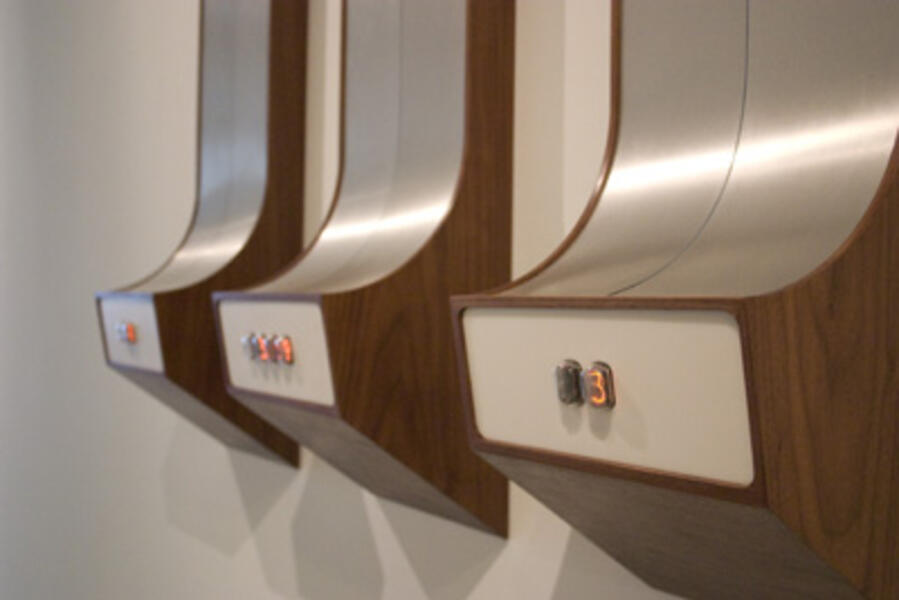 SN-220060" x 36" x 10" | walnut, corian, aluminum, electronics | 2011 displays data from facebook - number of groups, friends, and upcoming events
SN-220060" x 36" x 10" | walnut, corian, aluminum, electronics | 2011 displays data from facebook - number of groups, friends, and upcoming events -
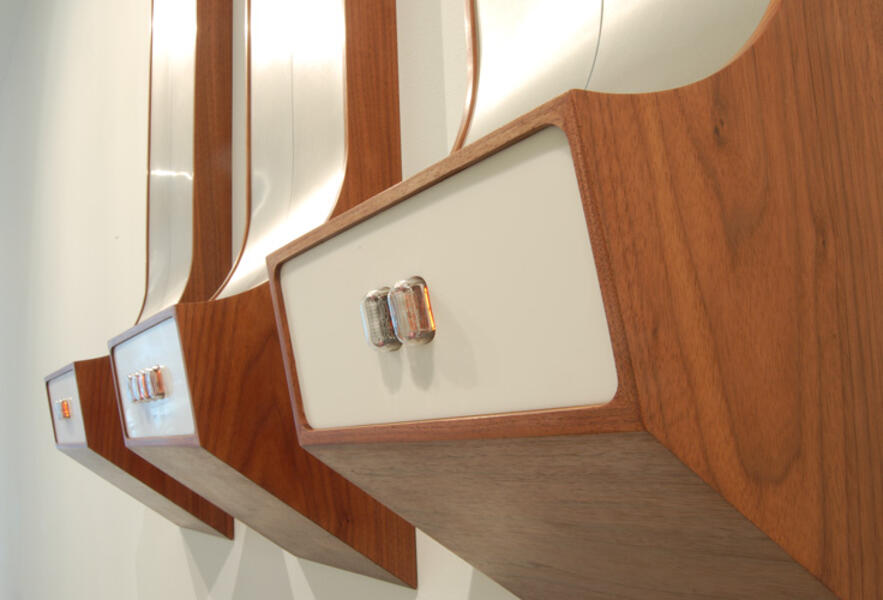 SN-220060" x 36" x 10" | walnut, corian, aluminum, electronics | 2011 displays data from facebook - number of groups, friends, and upcoming events
SN-220060" x 36" x 10" | walnut, corian, aluminum, electronics | 2011 displays data from facebook - number of groups, friends, and upcoming events -
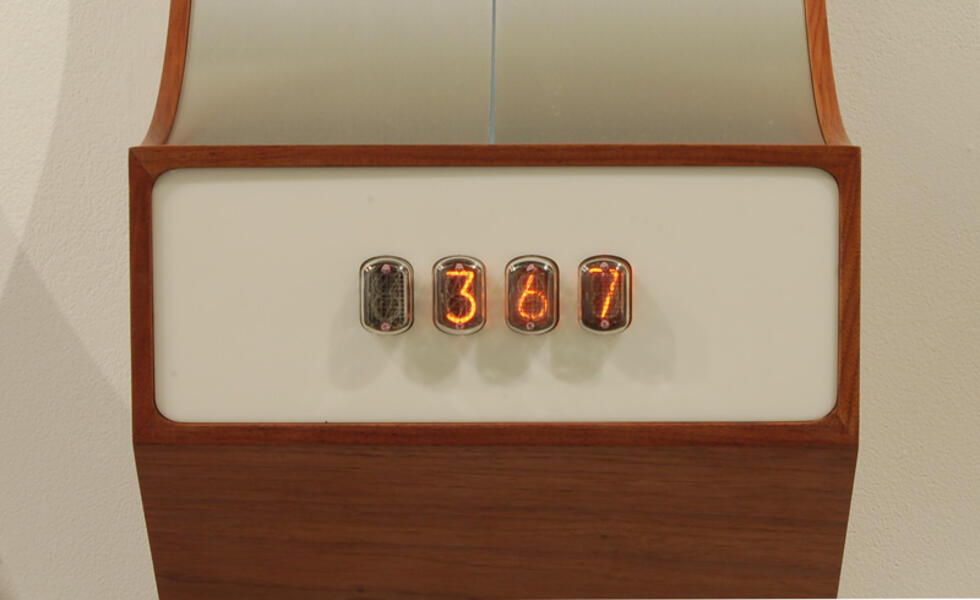 SN-2200The 2200 Series is an exploration of the networks that define and locate an individual socially, geographically, and otherwise, with a particular focus on the networks that function via digital means. These pieces look to 1960's mainframe computers as the antecedents of our contemporary situation, and explore overlaps with modernist furniture suites which themselves generate and exist within their own network. Each piece functions as a computer, retrieving web-based data about an individual and displaying this information in the piece. With this abstract information grounded in a tangible object, the viewer is able to reflect upon these networks in a new way.
SN-2200The 2200 Series is an exploration of the networks that define and locate an individual socially, geographically, and otherwise, with a particular focus on the networks that function via digital means. These pieces look to 1960's mainframe computers as the antecedents of our contemporary situation, and explore overlaps with modernist furniture suites which themselves generate and exist within their own network. Each piece functions as a computer, retrieving web-based data about an individual and displaying this information in the piece. With this abstract information grounded in a tangible object, the viewer is able to reflect upon these networks in a new way. -
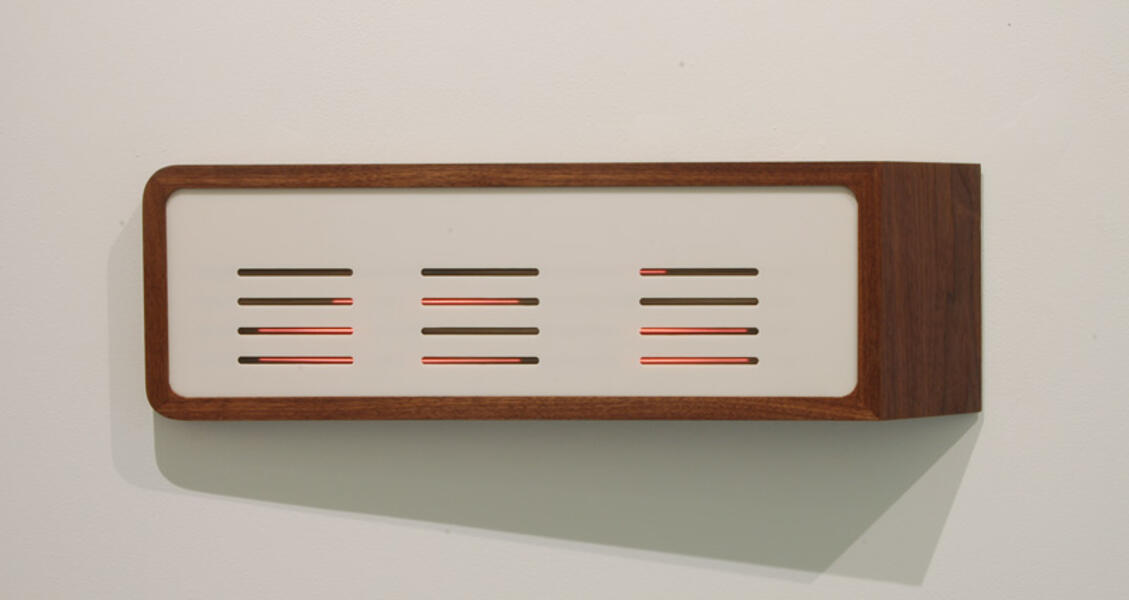 GL-220030" x 9" x 4" | walnut, corian, electronics | 2011 displays data from geolocation sharing service regarding number of people checked in at visited locations
GL-220030" x 9" x 4" | walnut, corian, electronics | 2011 displays data from geolocation sharing service regarding number of people checked in at visited locations -
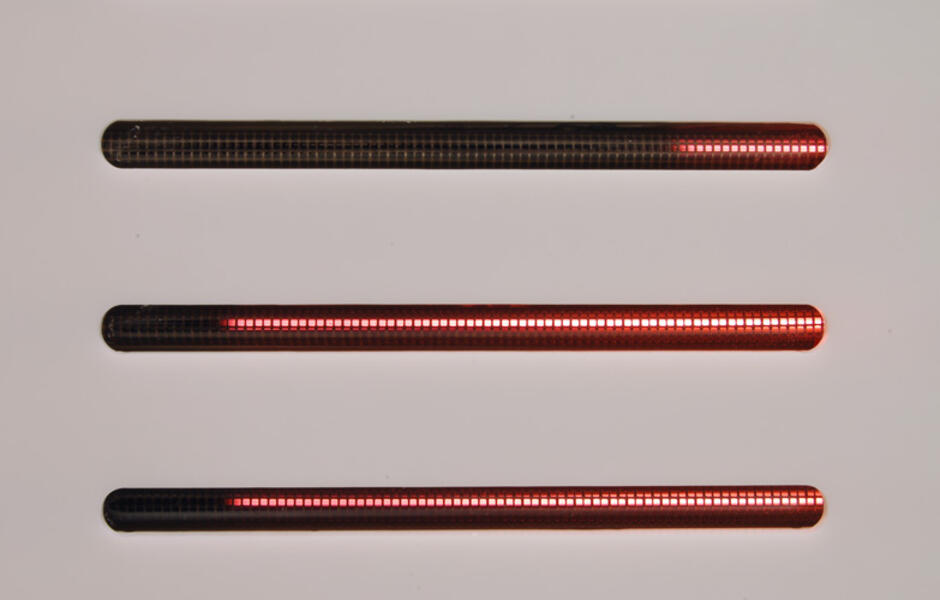 GL-220030" x 9" x 4" | walnut, corian, electronics | 2011 displays data from geolocation sharing service regarding number of people checked in at visited locations
GL-220030" x 9" x 4" | walnut, corian, electronics | 2011 displays data from geolocation sharing service regarding number of people checked in at visited locations -
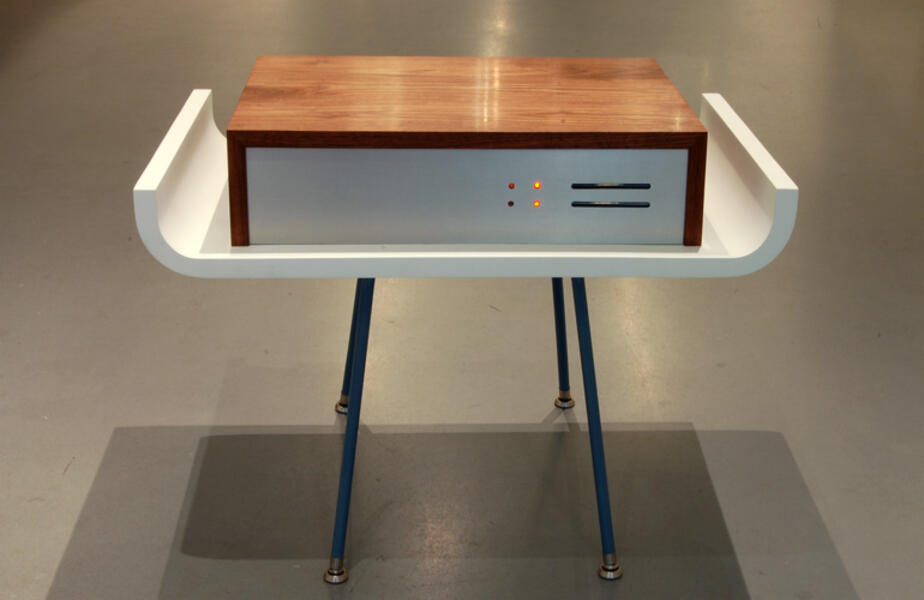 LS-220032" x 30" x 20" | cast plastic, walnut, aluminum, steel, electronics | 2011 displays data from twitter - time since last tweet, time since last mention
LS-220032" x 30" x 20" | cast plastic, walnut, aluminum, steel, electronics | 2011 displays data from twitter - time since last tweet, time since last mention -
 LS-220032" x 30" x 20" | cast plastic, walnut, aluminum, steel, electronics | 2011 displays data from twitter - time since last tweet, time since last mention
LS-220032" x 30" x 20" | cast plastic, walnut, aluminum, steel, electronics | 2011 displays data from twitter - time since last tweet, time since last mention
Sculpting with Satellites
The works in the "Sculpting with Satellites" series began as walks through the artist’s neighborhood. These travels were tracked via global positioning system. The GPS data was then processed through a script written by the artist that plots this data into 3D modeling software, scaling the points within a Cartesian cube. This generated a path through space with a width that is modulated according to the speed at which he was moving. These were then brought out of digital space by a variety of computer aided machining techniques. The series includes sculptural renderings of these paths, created by the artist using a 3D printer. Other sculptures are selections from these paths, chosen as studies, and created as physical objects by milling and laminating. These objects were then resolved in a sculptural manner, employing an aesthetic sensibility that is rooted in a non-linguistic understanding of space, material, and form.
These spaces and translations were further explored in a series of drawings. Images from this process were captured in the 3D software and etched into acrylic using a laser cutter. These etchings were then in-filled with paint to make the images visible.
These spaces and translations were further explored in a series of drawings. Images from this process were captured in the 3D software and etched into acrylic using a laser cutter. These etchings were then in-filled with paint to make the images visible.
-
 Monument 12The "Sculpting with Satellites" series began as walks through the artist’s neighborhood. These travels were tracked via global positioning system. The GPS data was then processed through a script written by the artist that plots this data into 3D modeling software, scaling the points within a Cartesian cube. This generated a path through space with a width that is modulated according to the speed at which he was moving. These were then brought out of digital space by a variety of computer aided machining techniques. The series includes sculptural renderings of these paths, created by the artist using a 3D printer. Other sculptures are selections from these paths, chosen as studies, and created as physical objects by milling and laminating. These objects were then resolved in a sculptural manner, employing an aesthetic sensibility that is rooted in a non-linguistic understanding of space, material, and form.
Monument 12The "Sculpting with Satellites" series began as walks through the artist’s neighborhood. These travels were tracked via global positioning system. The GPS data was then processed through a script written by the artist that plots this data into 3D modeling software, scaling the points within a Cartesian cube. This generated a path through space with a width that is modulated according to the speed at which he was moving. These were then brought out of digital space by a variety of computer aided machining techniques. The series includes sculptural renderings of these paths, created by the artist using a 3D printer. Other sculptures are selections from these paths, chosen as studies, and created as physical objects by milling and laminating. These objects were then resolved in a sculptural manner, employing an aesthetic sensibility that is rooted in a non-linguistic understanding of space, material, and form. -
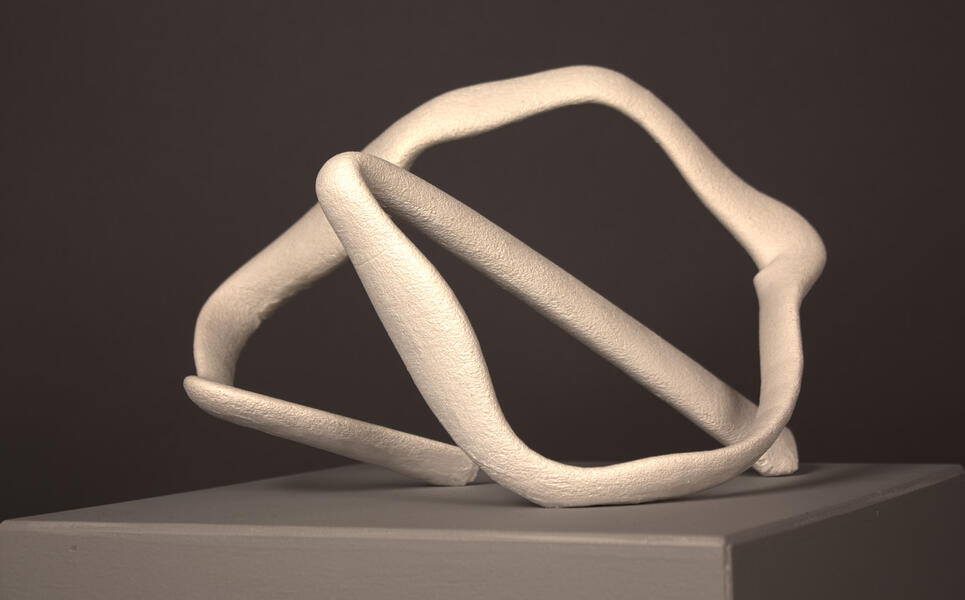 Monument 3powder-based 3D print, acrylic paint 10” x 7” x 7”
Monument 3powder-based 3D print, acrylic paint 10” x 7” x 7” -
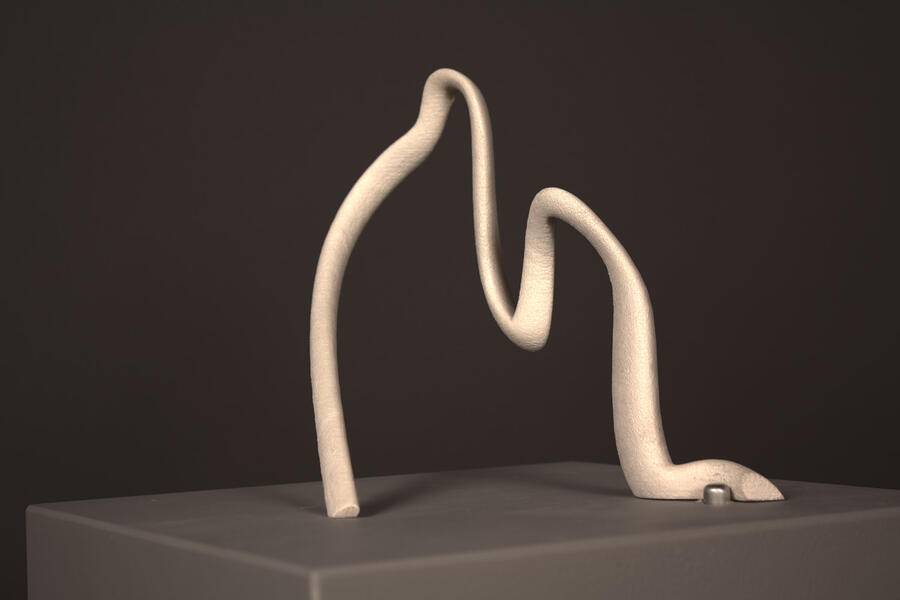 Monument 5powder-based 3D print, acrylic paint 6” x 7” x 8”
Monument 5powder-based 3D print, acrylic paint 6” x 7” x 8” -
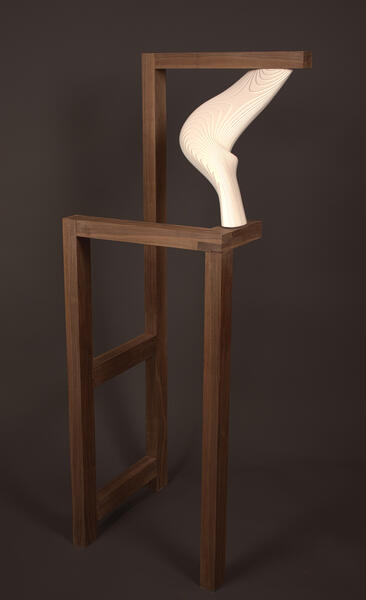 Foldwalnut, acrylic, aluminum 19” x 56” x 19”
Foldwalnut, acrylic, aluminum 19” x 56” x 19” -
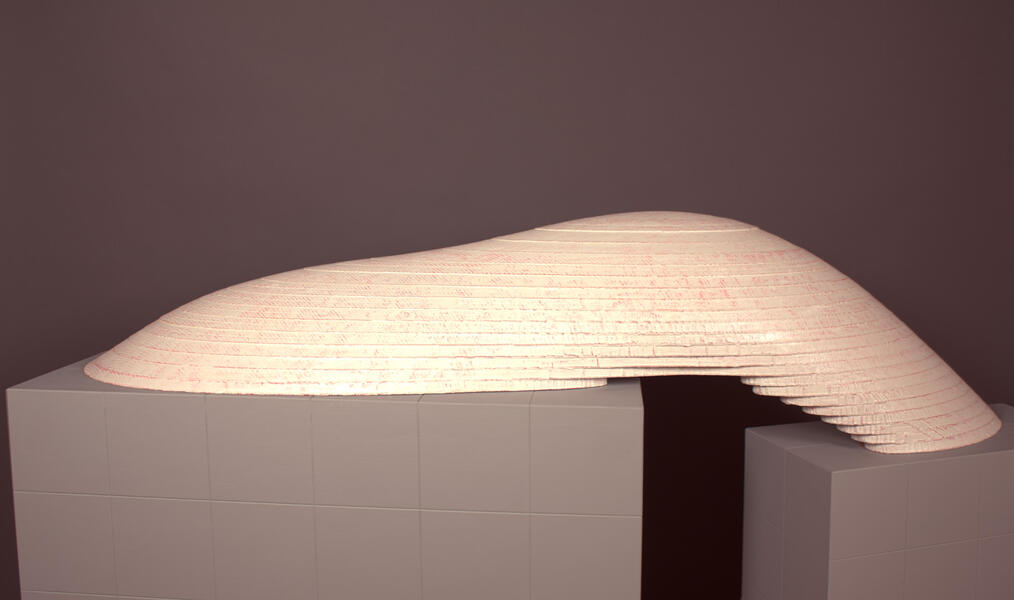 ApexMDF, acrylic paint 72” x 20” x 13”
ApexMDF, acrylic paint 72” x 20” x 13” -
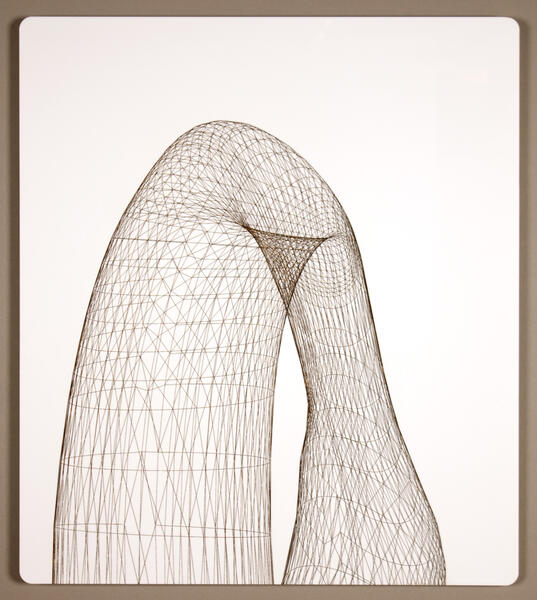 Peakacrylic paint on etched acrylic 19” x 24”
Peakacrylic paint on etched acrylic 19” x 24” -
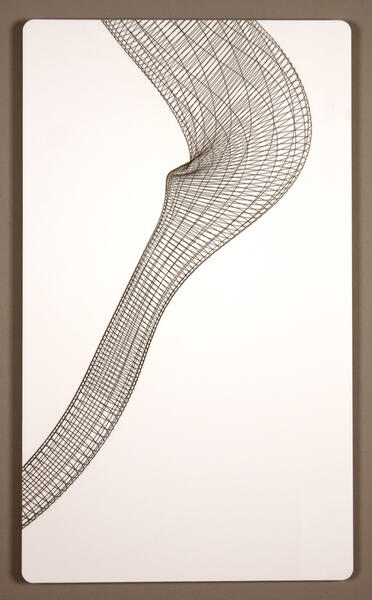 Flexacrylic paint on etched acrylic 14” x 24”
Flexacrylic paint on etched acrylic 14” x 24” -
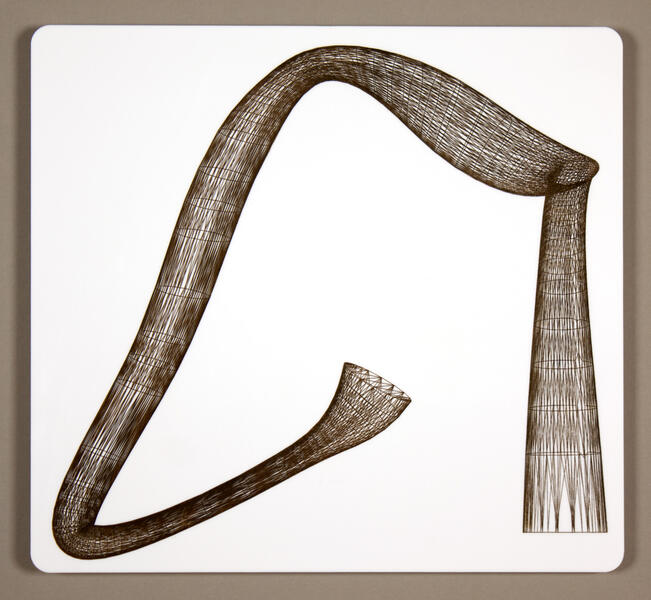 PressAcrylic paint on etched acrylic 15” x 14”
PressAcrylic paint on etched acrylic 15” x 14” -
 Riseacrylic paint on etched acrylic 18” x 30”
Riseacrylic paint on etched acrylic 18” x 30” -
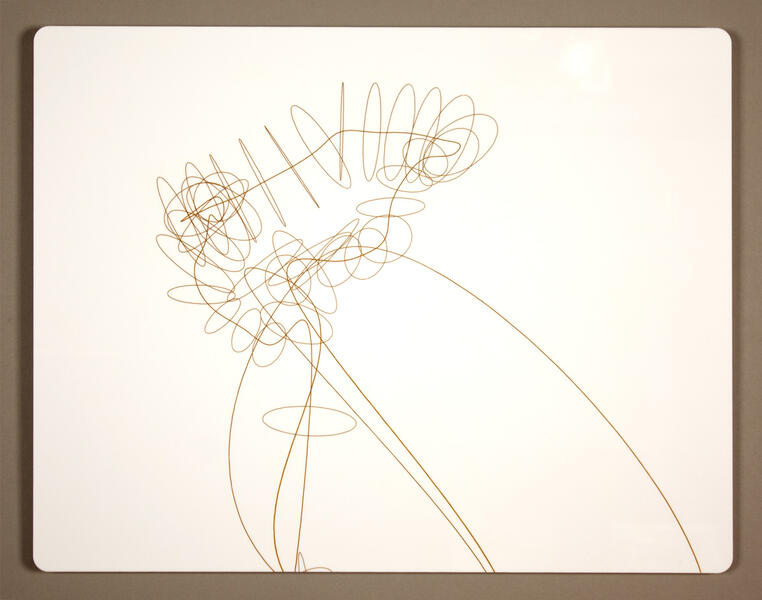 Baseacrylic paint on etched acrylic 22” x 17”
Baseacrylic paint on etched acrylic 22” x 17”
motion studies
This is a series of drawings based on skeletal tracking.The artist's movement is captured using a Microsoft Kinect and this skeletal data is plotted into 3D modeling software. Images from these models are then etched into acrylic using a laser cutter and the etched lines are filled with paint to create the image.
Parametric Domestics
The "Parametric Domestics" series employs parametric 3D modeling and digital fabrication techniques to create odd yet familiar objects. This body of work is an exploration of 3D modeling and its impact on the objects that surround us. Some of the sculptures incorporate contemporary domestic objects which are integrated into the work with precisely fabricated connections created with various 3D printing technologies. Other works are small intimate pieces that imply some kind of domestic function.
-
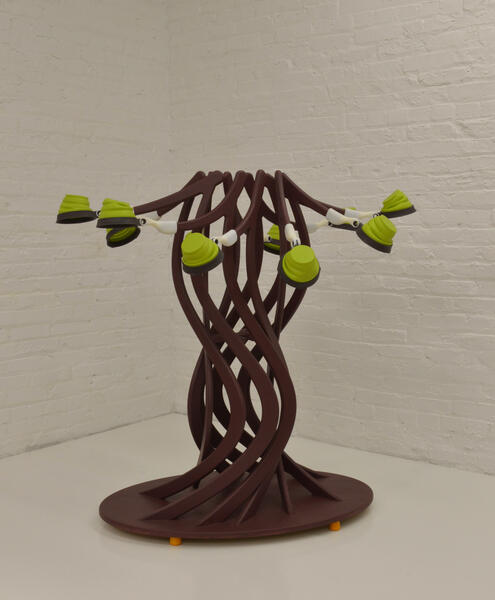 Awkward PartyMDF, measuring cups, photopolymer 3D prints, acrylic paint, rubber furniture feet
Awkward PartyMDF, measuring cups, photopolymer 3D prints, acrylic paint, rubber furniture feet -
 Awkward Party (detail)MDF, measuring cups, photopolymer 3D prints, acrylic paint, rubber furniture feet
Awkward Party (detail)MDF, measuring cups, photopolymer 3D prints, acrylic paint, rubber furniture feet -
 number to point to line to form to number to point to line to form to.... (detail)powder-based 3D print, photopolymer 3D print, extension pole, MDF, acrylic, paint 6' x 2' x 2'
number to point to line to form to number to point to line to form to.... (detail)powder-based 3D print, photopolymer 3D print, extension pole, MDF, acrylic, paint 6' x 2' x 2' -
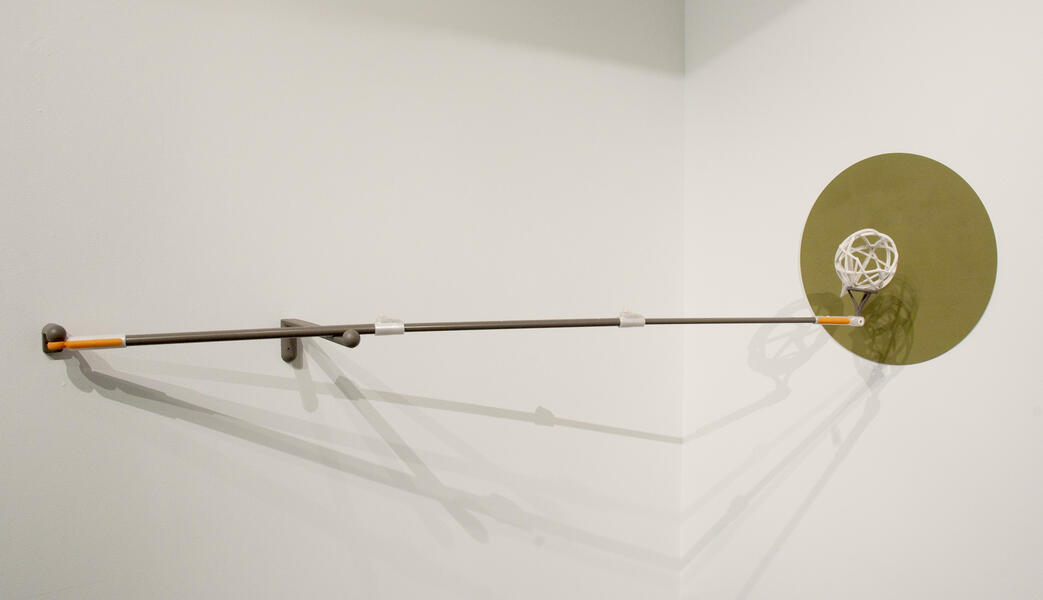 number to point to line to form to number to point to line to form to.... (detail)powder-based 3D print, photopolymer 3D print, extension pole, MDF, acrylic, paint 6' x 2' x 2'
number to point to line to form to number to point to line to form to.... (detail)powder-based 3D print, photopolymer 3D print, extension pole, MDF, acrylic, paint 6' x 2' x 2' -
 Capitalplaster-based 3D print, walnut, gold leaf, tung oil
Capitalplaster-based 3D print, walnut, gold leaf, tung oil
cellular physics studies
These drawings are made by etching into acrylic panels with a laser cutter, then filling the etched lines with paint. The images are made in 3D modeling software (Rhino) using a script written by the artist in a plug-in (Grasshopper). The script builds these hexagonal-cell structures based upon gestural movements. The artist's motion is captured with a Microsoft Kinect and fed into the software. After this structure is built in the modeling environment, it is then "pushed" around via physical movement captured by the Kinect. Utilizing a physics engine (Kangaroo) in the software, the structures bend, slide, and collapse in response to the artist's actions. These works are an exploration of patterns that exist in nature, though often at the microscopic level. The hexagonal pattern is similar to the molecular structure of cellulose, which the artist is currently studying in the process of developing a 3D bio-printer. Exploring these forms in a much larger simulated space brings new meaning and vitality to this research.
Bioprinting
Nature has remarkable abilities to efficiently create complex materials with a remarkable "bottom-up" approach. Our most advanced forms of fabrication employ digital systems of control to create form, utilizing a more "top-down" approach. Combining these two with bioprinitng offers exciting possibilities for growing new forms with novel properties.
I am working in collaboration with several people at the Baltimore Under Ground Science Space, a community biology lab, to develop a 3D printing processes with biological material. We are an interdisciplinary group of biologists, engineers, and artists. We are exploring multiple approaches to bioprinting including syringe-based printing of cells suspended in agar, filament-based printing with polycaprolactone, and DLP Stereolithography with photopolymer hydrogels. We have focused on printing with plant cells and genetically engineered bacteria, and are also now working with microbial cellulose. Our work is related to much of the research in organ printing, but is also inspired by exciting new work in biofabrication that utilizes biology to create novel materials and forms. Our creative approach leverages and advances open-source technology with innovations in hardware, software, biological media, and lab protocols.
I am working in collaboration with several people at the Baltimore Under Ground Science Space, a community biology lab, to develop a 3D printing processes with biological material. We are an interdisciplinary group of biologists, engineers, and artists. We are exploring multiple approaches to bioprinting including syringe-based printing of cells suspended in agar, filament-based printing with polycaprolactone, and DLP Stereolithography with photopolymer hydrogels. We have focused on printing with plant cells and genetically engineered bacteria, and are also now working with microbial cellulose. Our work is related to much of the research in organ printing, but is also inspired by exciting new work in biofabrication that utilizes biology to create novel materials and forms. Our creative approach leverages and advances open-source technology with innovations in hardware, software, biological media, and lab protocols.
-
 Bioprint I6" x 8" x 6" | 3D print — of Arabidopsis plant cells, agar, and growth media — bell jar, antimicrobial filters, aluminum, walnut | 2014
Bioprint I6" x 8" x 6" | 3D print — of Arabidopsis plant cells, agar, and growth media — bell jar, antimicrobial filters, aluminum, walnut | 2014 -
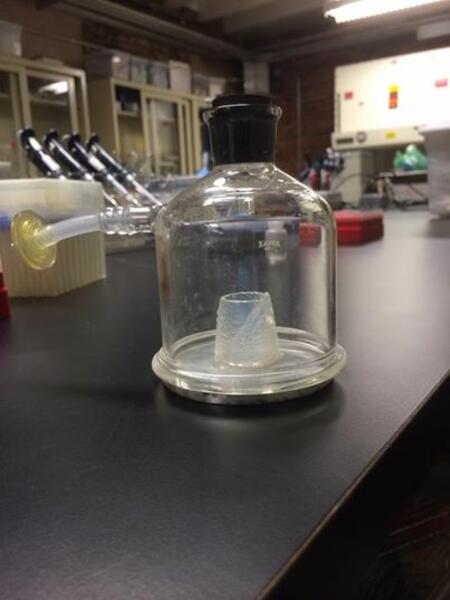 Bioprint in lab
Bioprint in lab -
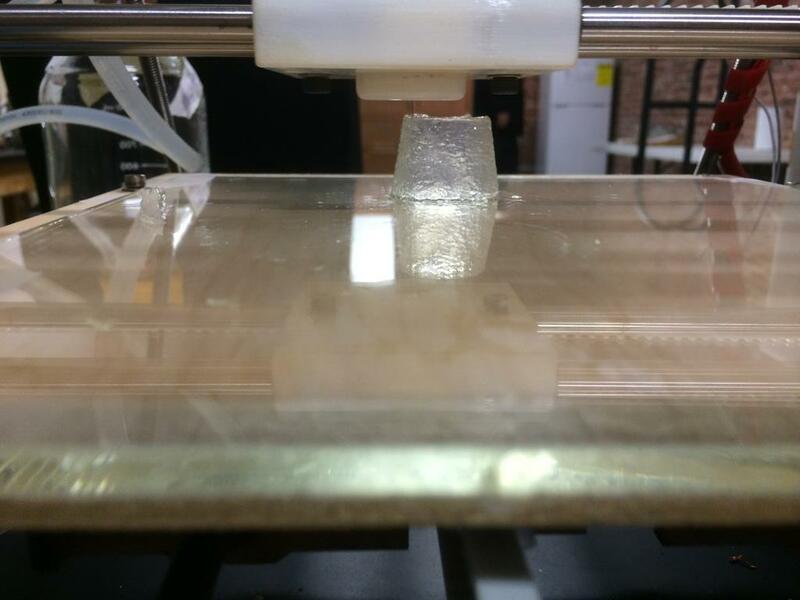 Bioprint in progressFirst successful 3D print of plant cells.
Bioprint in progressFirst successful 3D print of plant cells. -
video of first 3D print with plant cells
-
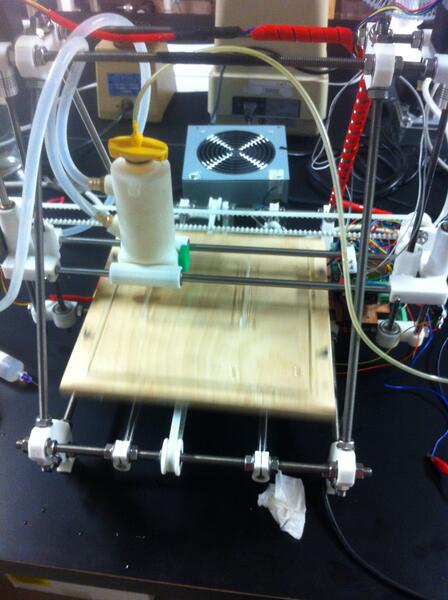 Bioprinter v1Modified RepRap Prusa Mendel
Bioprinter v1Modified RepRap Prusa Mendel -
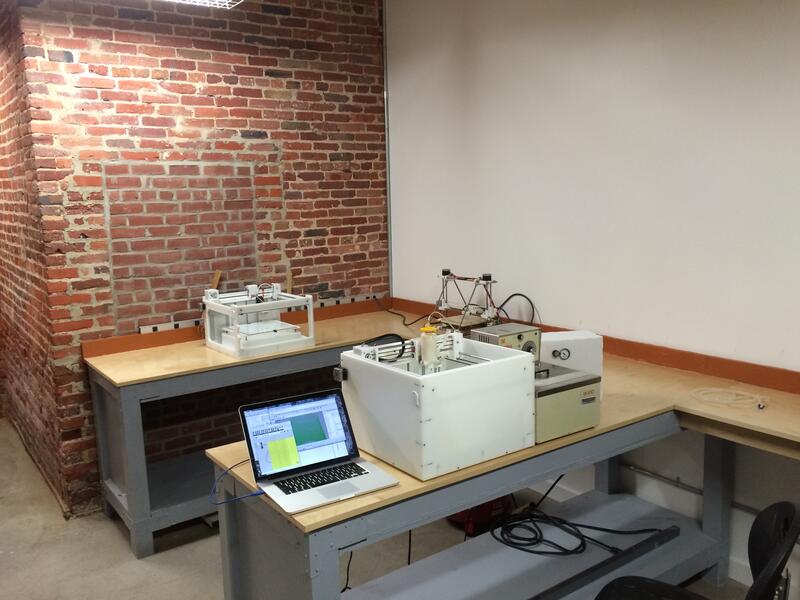 Bioprinter v2Modified jimmi beta
Bioprinter v2Modified jimmi beta -
 prints and cells in incubatorfirst prints in the incubator at the Baltimore Underground Science Space, along with flasks of circulating Arabadopsis cells cultured by collaborators at BUGSS
prints and cells in incubatorfirst prints in the incubator at the Baltimore Underground Science Space, along with flasks of circulating Arabadopsis cells cultured by collaborators at BUGSS -
 printed Arabadopsis cellsView under microscope confirms that cells remain viable after extrusion.
printed Arabadopsis cellsView under microscope confirms that cells remain viable after extrusion. -
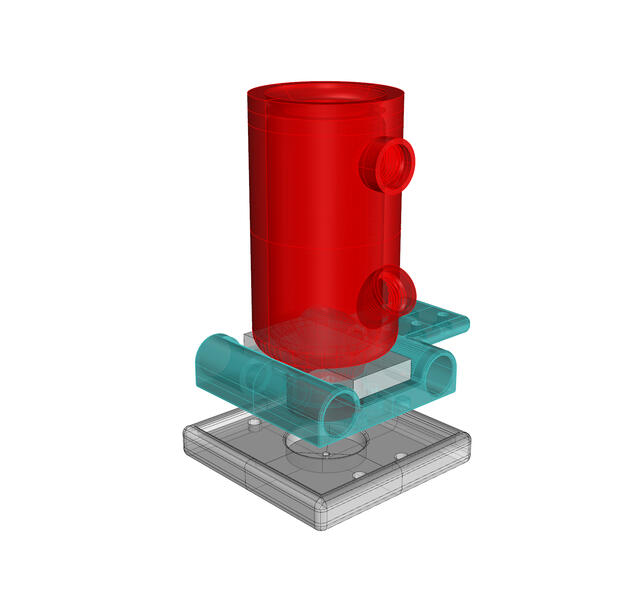 hot water jacket extruder
hot water jacket extruder
Arborescent Algorithms
To be human is to live at the intersection of technological and biological systems. Our first inventions were weapons to protect our bodies and tools to cultivate crops. Today our mobile phones monitor our health and seeds are planted by tractors controlled by GPS and detailed data. We are now at a tipping point, where the boundaries of these systems are blurring. Our knowledge of biology is advancing and being engineered into forms that are accessible to digital computation. We now use computers to find and also design new genes. Just as our cars, clothing, and buildings now exist in CAD (computer-aided design) software before they are fabricated in the physical world, living things can now move from in silico to in vitro to in vivo.
We are able to code living things, not as a result of our technical abilities alone, but because nature itself is coded. Complex patterns are written by evolution, over billions of cycles of the seasons. The manner in which nature writes code is fascinating, idiosyncratic, and often quite beautiful. The works in the “arborescent algorithms” explores the relationship between biological code and digital code , by writing programs to "grow" trees. Growth patterns, on the macro scale, were derived from academic research and extensive observation. These patterns were translated into an algorithm embedded in a CAD program. Through the manipulation of multiple inputs, a near-infinite variety of trees can be made, resembling a wide range of different species. These trees are then 3D printed in nylon and displayed as components of digitally fabricated sculptures.
We are able to code living things, not as a result of our technical abilities alone, but because nature itself is coded. Complex patterns are written by evolution, over billions of cycles of the seasons. The manner in which nature writes code is fascinating, idiosyncratic, and often quite beautiful. The works in the “arborescent algorithms” explores the relationship between biological code and digital code , by writing programs to "grow" trees. Growth patterns, on the macro scale, were derived from academic research and extensive observation. These patterns were translated into an algorithm embedded in a CAD program. Through the manipulation of multiple inputs, a near-infinite variety of trees can be made, resembling a wide range of different species. These trees are then 3D printed in nylon and displayed as components of digitally fabricated sculptures.
-
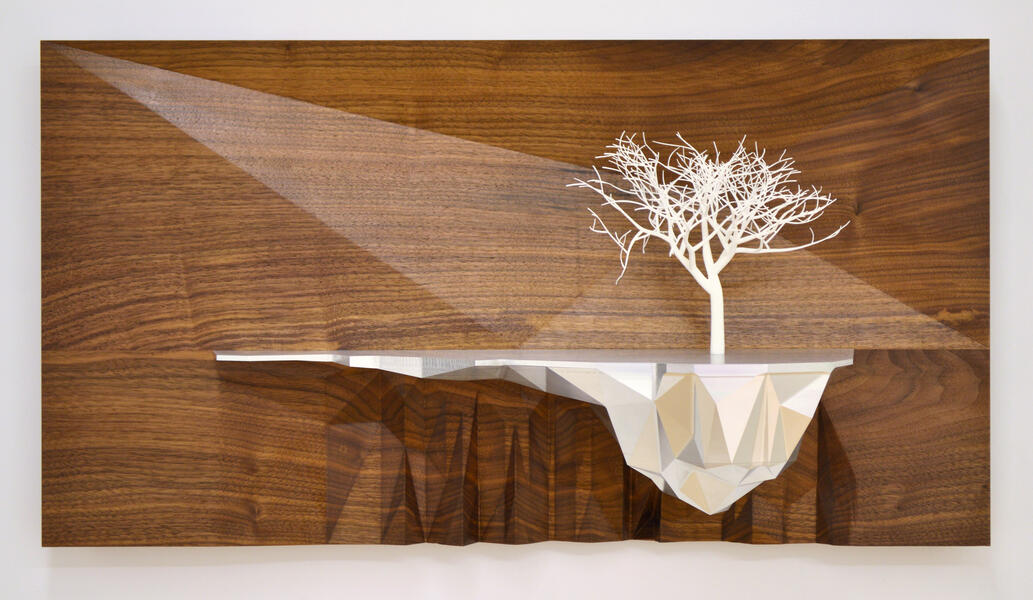 Arborescent Algorithm Series - Seed 5008-ALThe Arborescent Algorithms series operates at the intersection of nature and code. These tree forms are created by an algorithm that the artist has written to simulate natural growth patterns. A practically infinite number of unique trees can be made, and the inputs to the system can be adjusted to simulate a wide range of species. In addition to creating lovely forms, this process is designed to explore the degree to which natural systems can be coded. This work serves as research for the ongoing bio-printing project which aims to print with tree cells.
Arborescent Algorithm Series - Seed 5008-ALThe Arborescent Algorithms series operates at the intersection of nature and code. These tree forms are created by an algorithm that the artist has written to simulate natural growth patterns. A practically infinite number of unique trees can be made, and the inputs to the system can be adjusted to simulate a wide range of species. In addition to creating lovely forms, this process is designed to explore the degree to which natural systems can be coded. This work serves as research for the ongoing bio-printing project which aims to print with tree cells. -
 Arborescent Algorithm Series - Seed 5741-GKThe Arborescent Algorithms series operates at the intersection of nature and code. These tree forms are created by an algorithm that the artist has written to simulate natural growth patterns. A practically infinite number of unique trees can be made, and the inputs to the system can be adjusted to simulate a wide range of species. In addition to creating lovely forms, this process is designed to explore the degree to which natural systems can be coded. This work serves as research for the ongoing bio-printing project which aims to print with tree cells.
Arborescent Algorithm Series - Seed 5741-GKThe Arborescent Algorithms series operates at the intersection of nature and code. These tree forms are created by an algorithm that the artist has written to simulate natural growth patterns. A practically infinite number of unique trees can be made, and the inputs to the system can be adjusted to simulate a wide range of species. In addition to creating lovely forms, this process is designed to explore the degree to which natural systems can be coded. This work serves as research for the ongoing bio-printing project which aims to print with tree cells. -
 Arborescent Algorithm Series - Seed 5239-TWThe Arborescent Algorithms series operates at the intersection of nature and code. These tree forms are created by an algorithm that the artist has written to simulate natural growth patterns. A practically infinite number of unique trees can be made, and the inputs to the system can be adjusted to simulate a wide range of species. In addition to creating lovely forms, this process is designed to explore the degree to which natural systems can be coded. This work serves as research for the ongoing bio-printing project which aims to print with tree cells.
Arborescent Algorithm Series - Seed 5239-TWThe Arborescent Algorithms series operates at the intersection of nature and code. These tree forms are created by an algorithm that the artist has written to simulate natural growth patterns. A practically infinite number of unique trees can be made, and the inputs to the system can be adjusted to simulate a wide range of species. In addition to creating lovely forms, this process is designed to explore the degree to which natural systems can be coded. This work serves as research for the ongoing bio-printing project which aims to print with tree cells. -
 Holding Platforms with SpecimenThe Arborescent Algorithms series operates at the intersection of nature and code. These tree forms are created by an algorithm that the artist has written to simulate natural growth patterns. A practically infinite number of unique trees can be made, and the inputs to the system can be adjusted to simulate a wide range of species. In addition to creating lovely forms, this process is designed to explore the degree to which natural systems can be coded. This work serves as research for the ongoing bio-printing project which aims to print with tree cells. Operating at a degree of abstraction, this series also explores the idea of writing or rewriting natural code through genetic modification. The sculptures in this series are made by 3D printing the generated forms in nylon. The wall-mounted platforms are all made via CNC milling. e.
Holding Platforms with SpecimenThe Arborescent Algorithms series operates at the intersection of nature and code. These tree forms are created by an algorithm that the artist has written to simulate natural growth patterns. A practically infinite number of unique trees can be made, and the inputs to the system can be adjusted to simulate a wide range of species. In addition to creating lovely forms, this process is designed to explore the degree to which natural systems can be coded. This work serves as research for the ongoing bio-printing project which aims to print with tree cells. Operating at a degree of abstraction, this series also explores the idea of writing or rewriting natural code through genetic modification. The sculptures in this series are made by 3D printing the generated forms in nylon. The wall-mounted platforms are all made via CNC milling. e. -
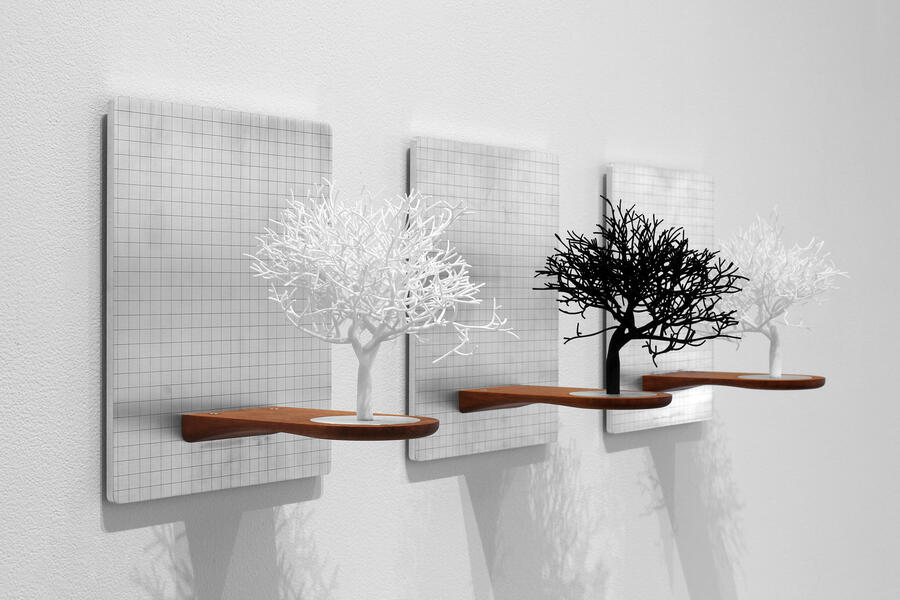 Holding Platforms with Specimin11" x 9" x 7" each | nylon 3D print, aluminum and walnut | 2014 created using an algorithm written by the artist that generates a nearly infinite number of trees based upon inputs and patterns found in nature.
Holding Platforms with Specimin11" x 9" x 7" each | nylon 3D print, aluminum and walnut | 2014 created using an algorithm written by the artist that generates a nearly infinite number of trees based upon inputs and patterns found in nature. -
 Observation Platform19" x 16" x 7" | nylon 3D print, aluminum and walnut | 2014 created using an algorithm written by the artist that generates a nearly infinite number of trees based upon inputs and patterns found in nature.
Observation Platform19" x 16" x 7" | nylon 3D print, aluminum and walnut | 2014 created using an algorithm written by the artist that generates a nearly infinite number of trees based upon inputs and patterns found in nature. -
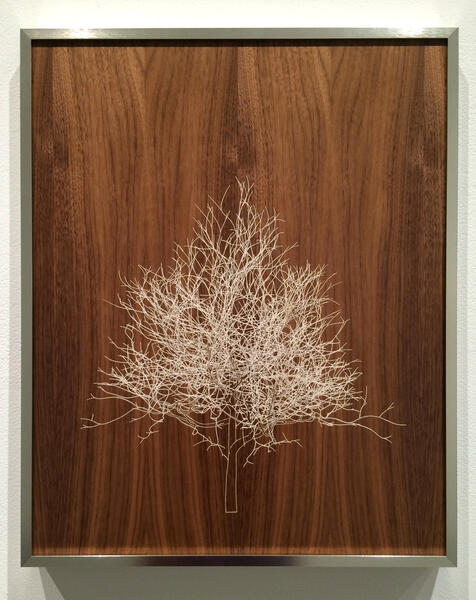 Arborescent Algorithms Series: Seed 1217" x 21" | acrylic on walnut plywood | 2014 These tree forms are created by an algorithm that the artist has written to simulate natural growth patterns. The drawings are etched into walnut plywood with a laser cutter, then the etched areas are in- filled with paint.
Arborescent Algorithms Series: Seed 1217" x 21" | acrylic on walnut plywood | 2014 These tree forms are created by an algorithm that the artist has written to simulate natural growth patterns. The drawings are etched into walnut plywood with a laser cutter, then the etched areas are in- filled with paint. -
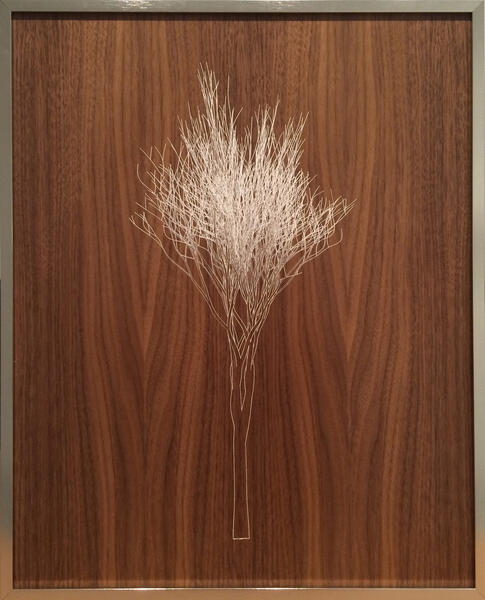 Arborescent Algorithms Series: Seed 2017" x 21" | acrylic on walnut plywood | 2014 These tree forms are created by an algorithm that the artist has written to simulate natural growth patterns. The drawings are etched into walnut plywood with a laser cutter, then the etched areas are in- filled with paint.
Arborescent Algorithms Series: Seed 2017" x 21" | acrylic on walnut plywood | 2014 These tree forms are created by an algorithm that the artist has written to simulate natural growth patterns. The drawings are etched into walnut plywood with a laser cutter, then the etched areas are in- filled with paint. -
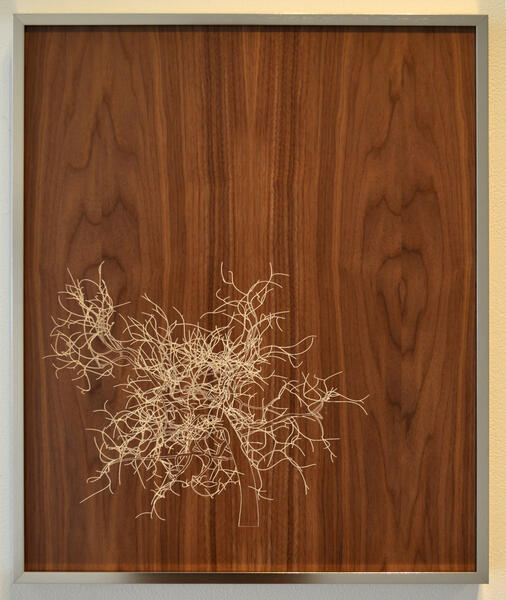 Arborescent Algorithms Series: Seed 45217" x 21" | acrylic on walnut plywood | 2014 These tree forms are created by an algorithm that the artist has written to simulate natural growth patterns. The drawings are etched into walnut plywood with a laser cutter, then the etched areas are in- filled with paint.
Arborescent Algorithms Series: Seed 45217" x 21" | acrylic on walnut plywood | 2014 These tree forms are created by an algorithm that the artist has written to simulate natural growth patterns. The drawings are etched into walnut plywood with a laser cutter, then the etched areas are in- filled with paint. -
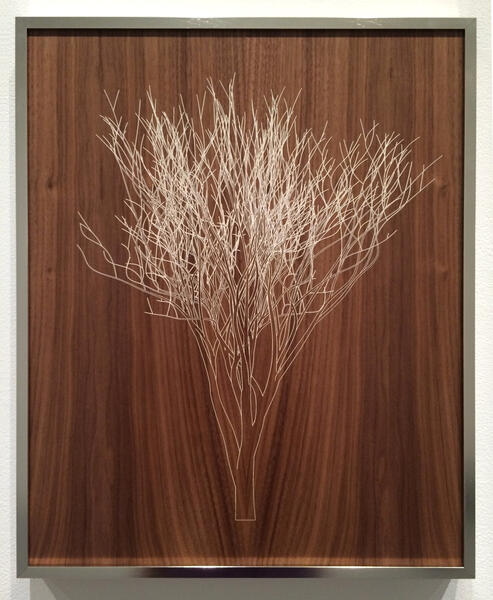 Arborescent Algorithms Series: Seed 94517" x 21" | acrylic on walnut plywood | 2014 These tree forms are created by an algorithm that the artist has written to simulate natural growth patterns. The drawings are etched into walnut plywood with a laser cutter, then the etched areas are in- filled with paint.
Arborescent Algorithms Series: Seed 94517" x 21" | acrylic on walnut plywood | 2014 These tree forms are created by an algorithm that the artist has written to simulate natural growth patterns. The drawings are etched into walnut plywood with a laser cutter, then the etched areas are in- filled with paint.
